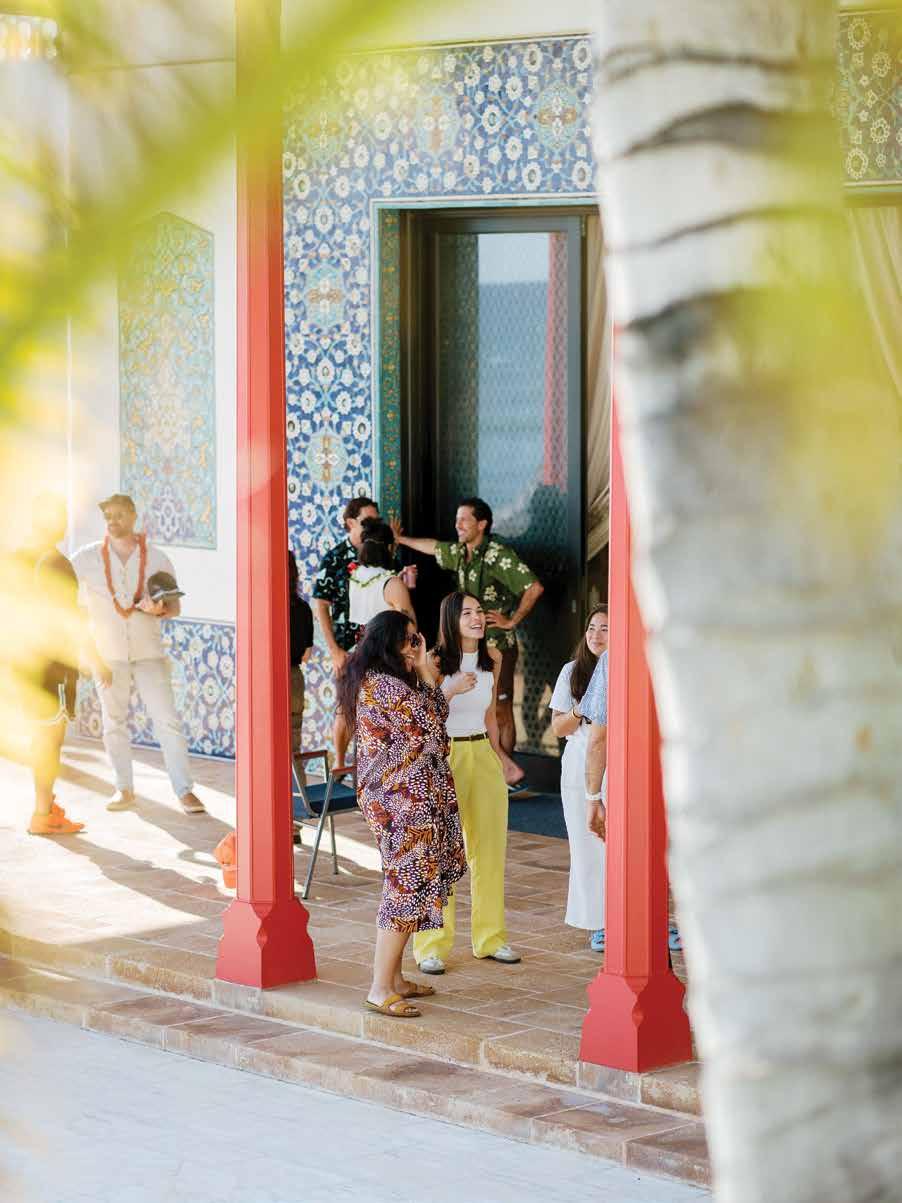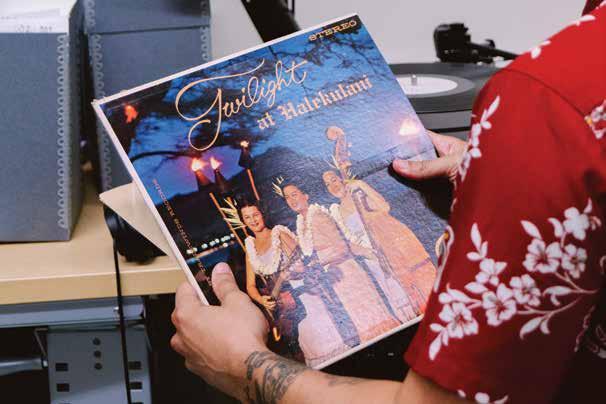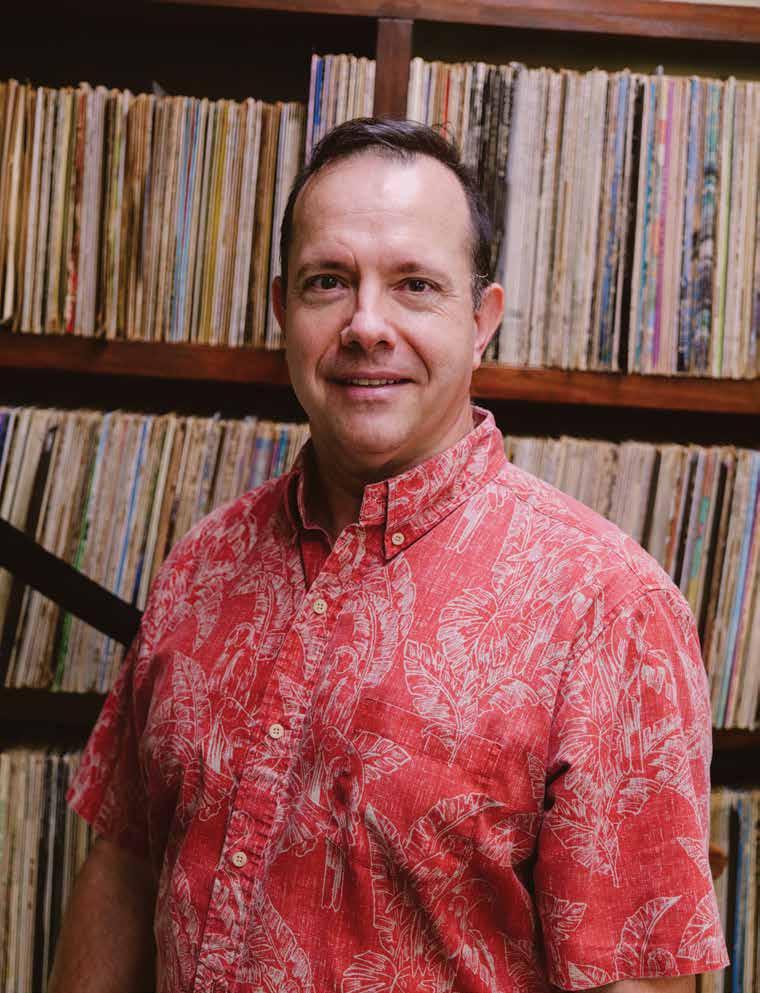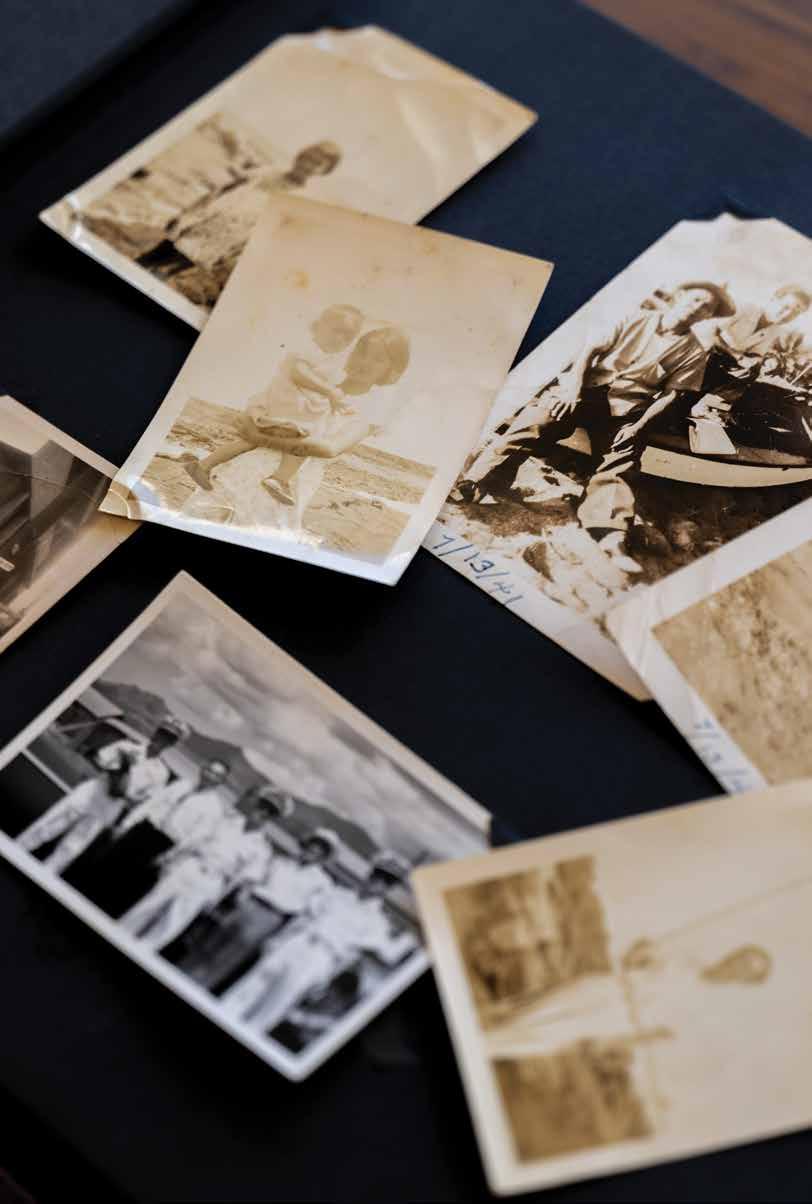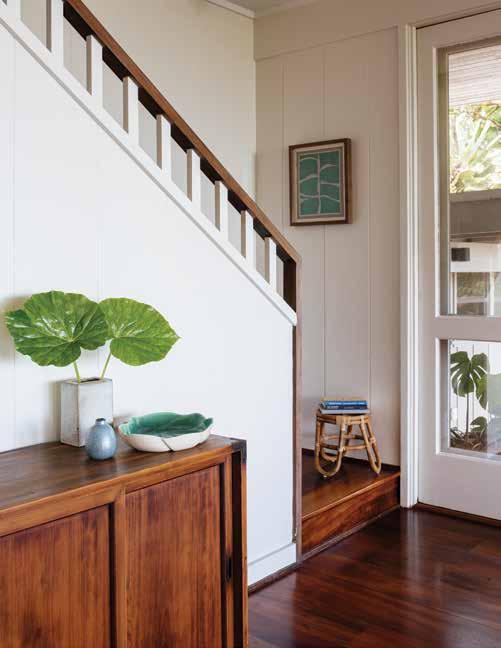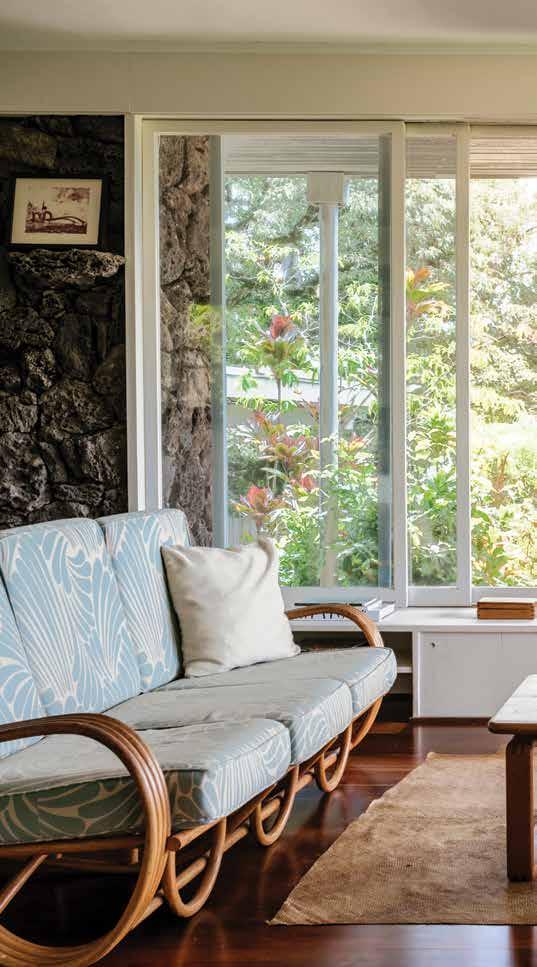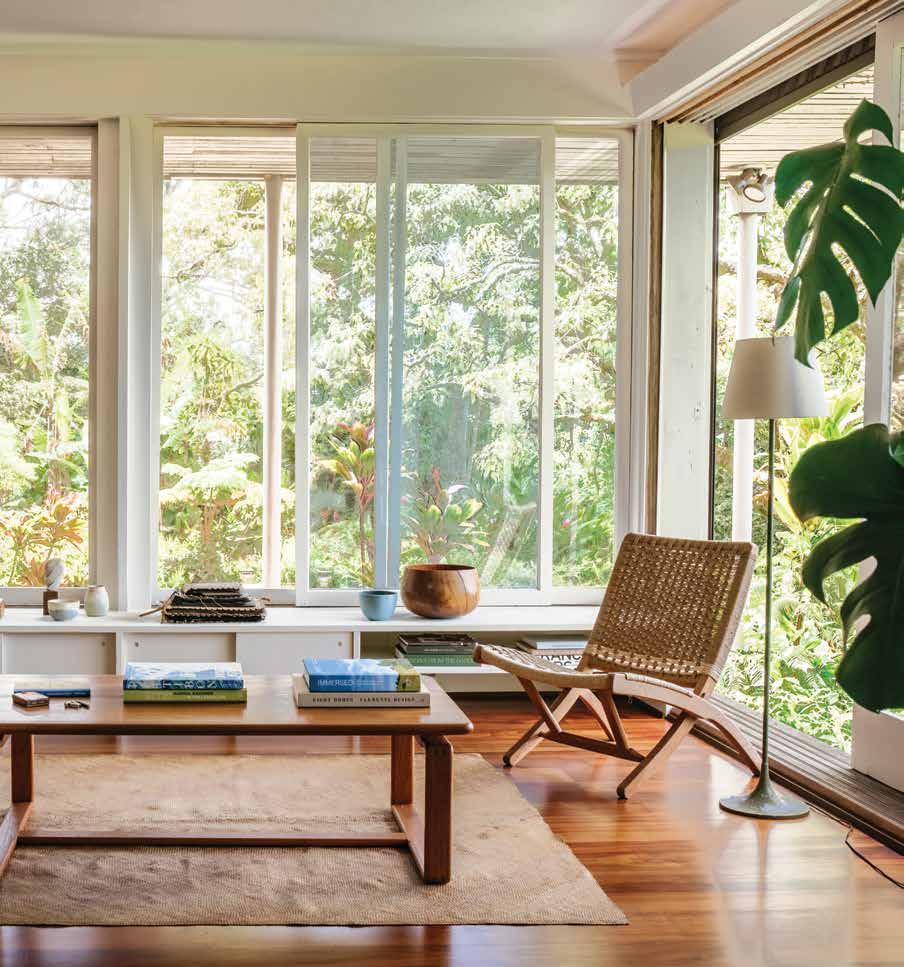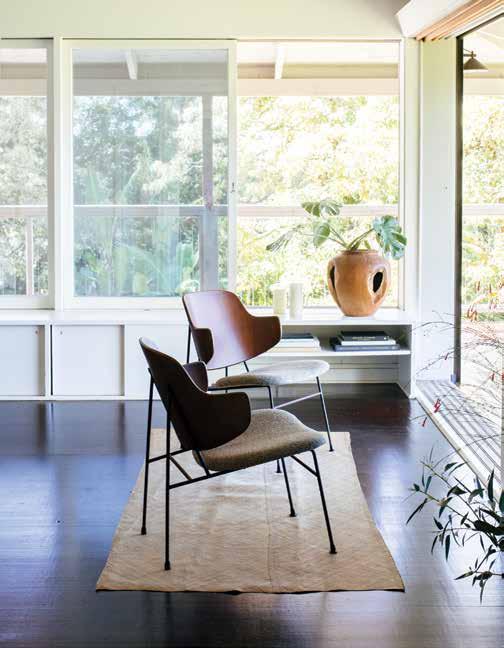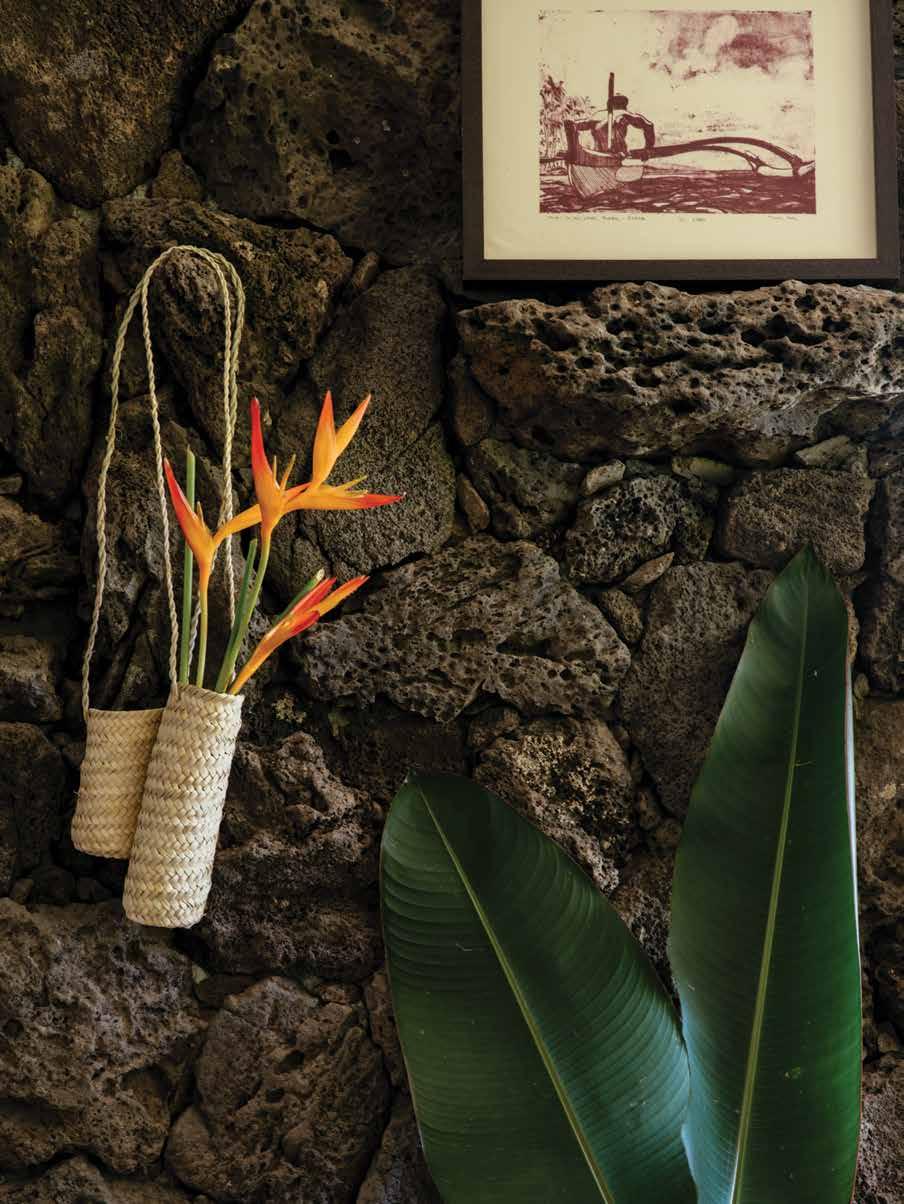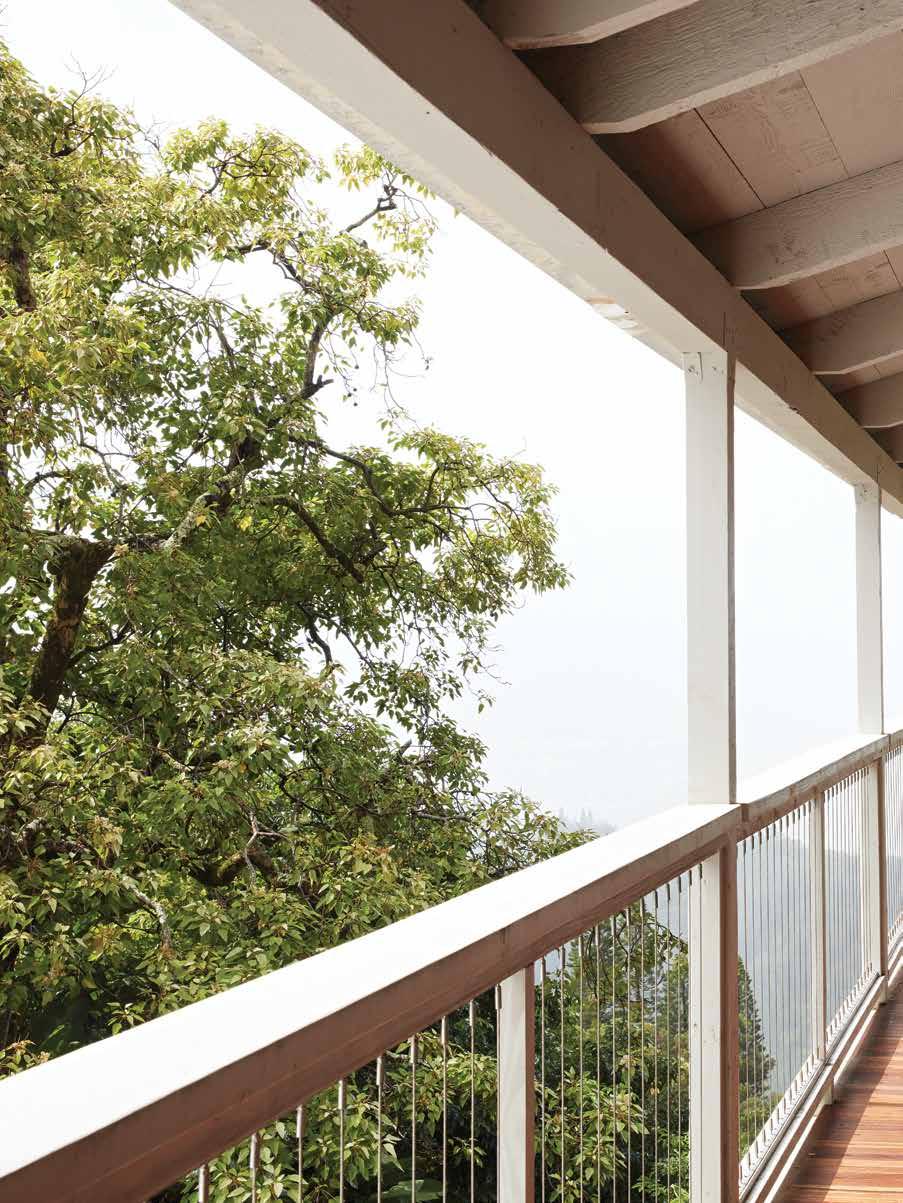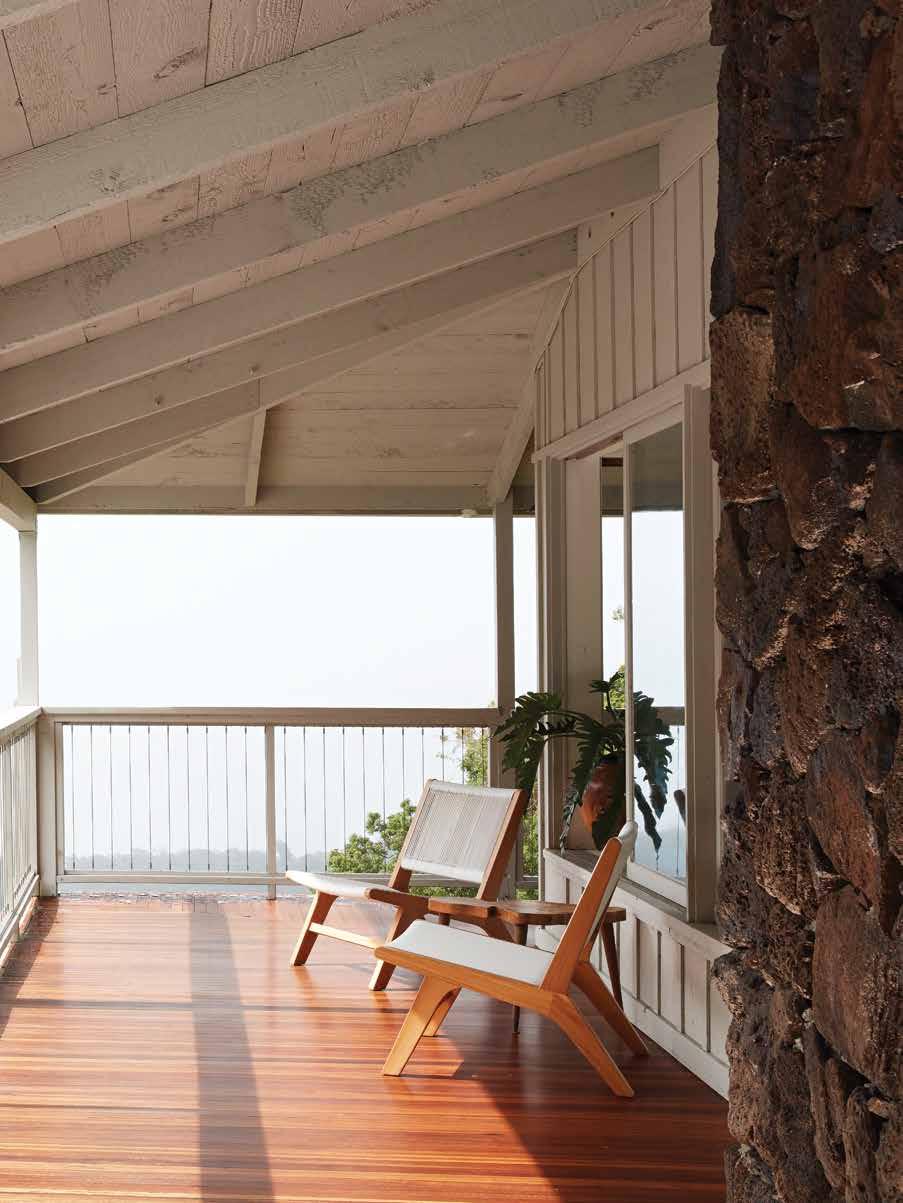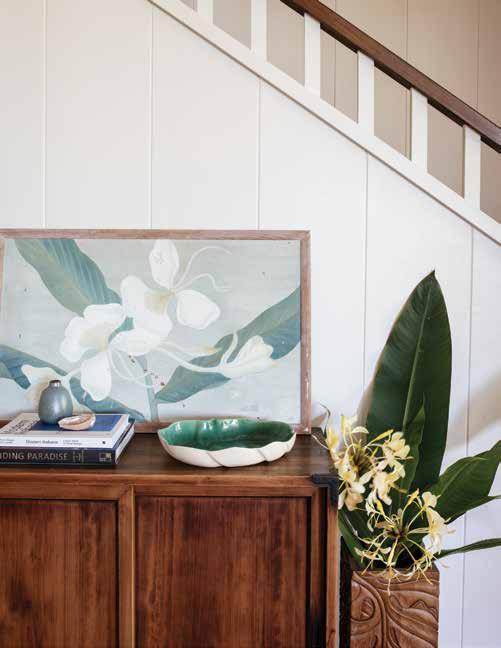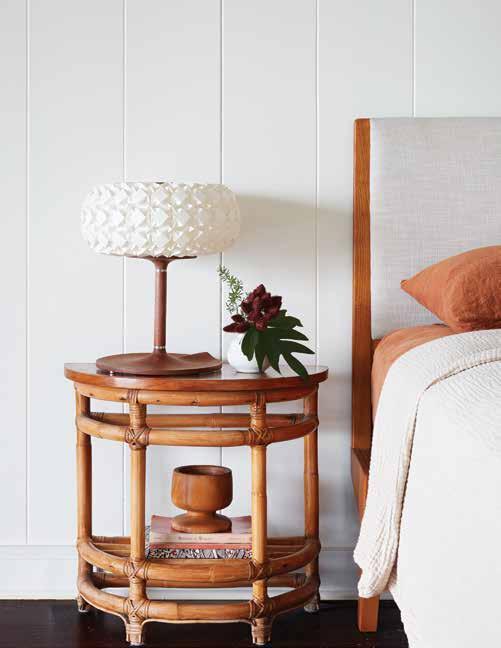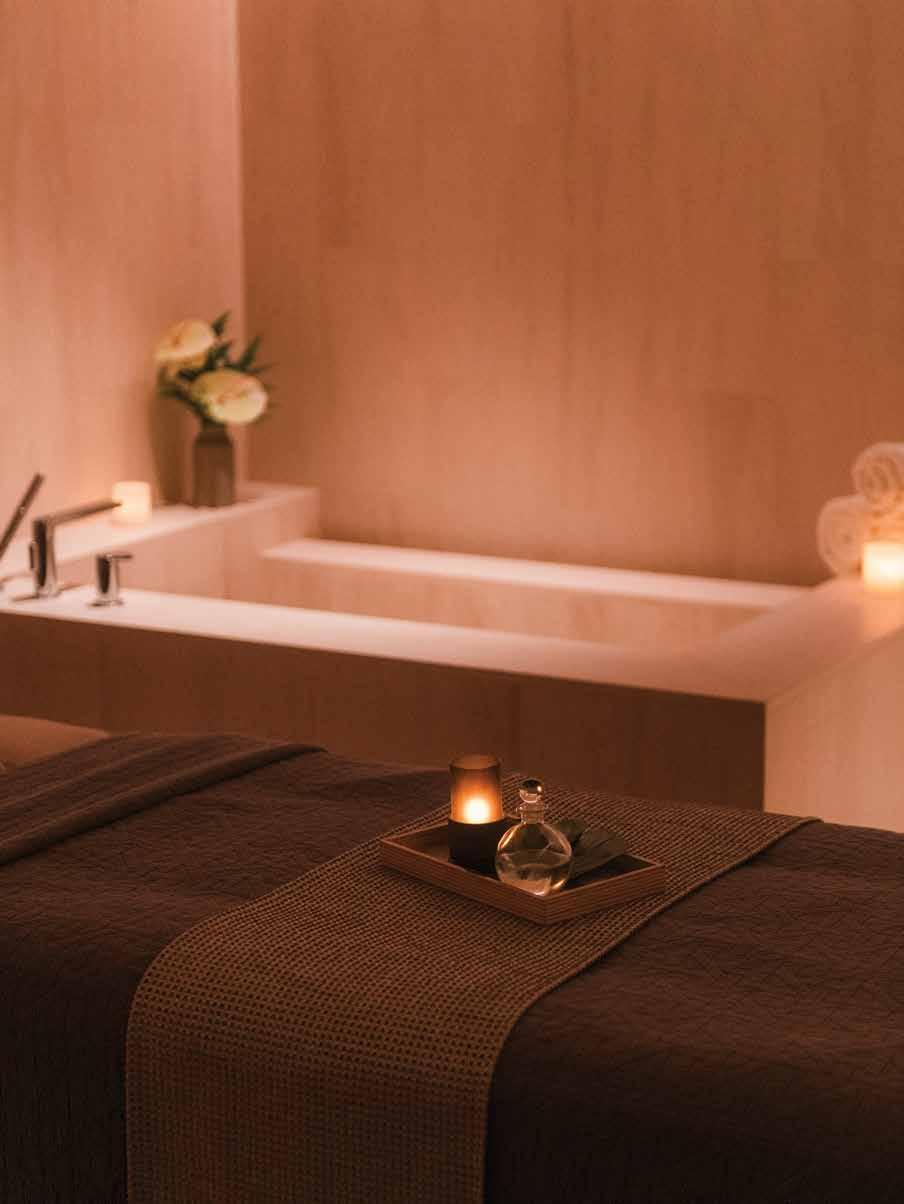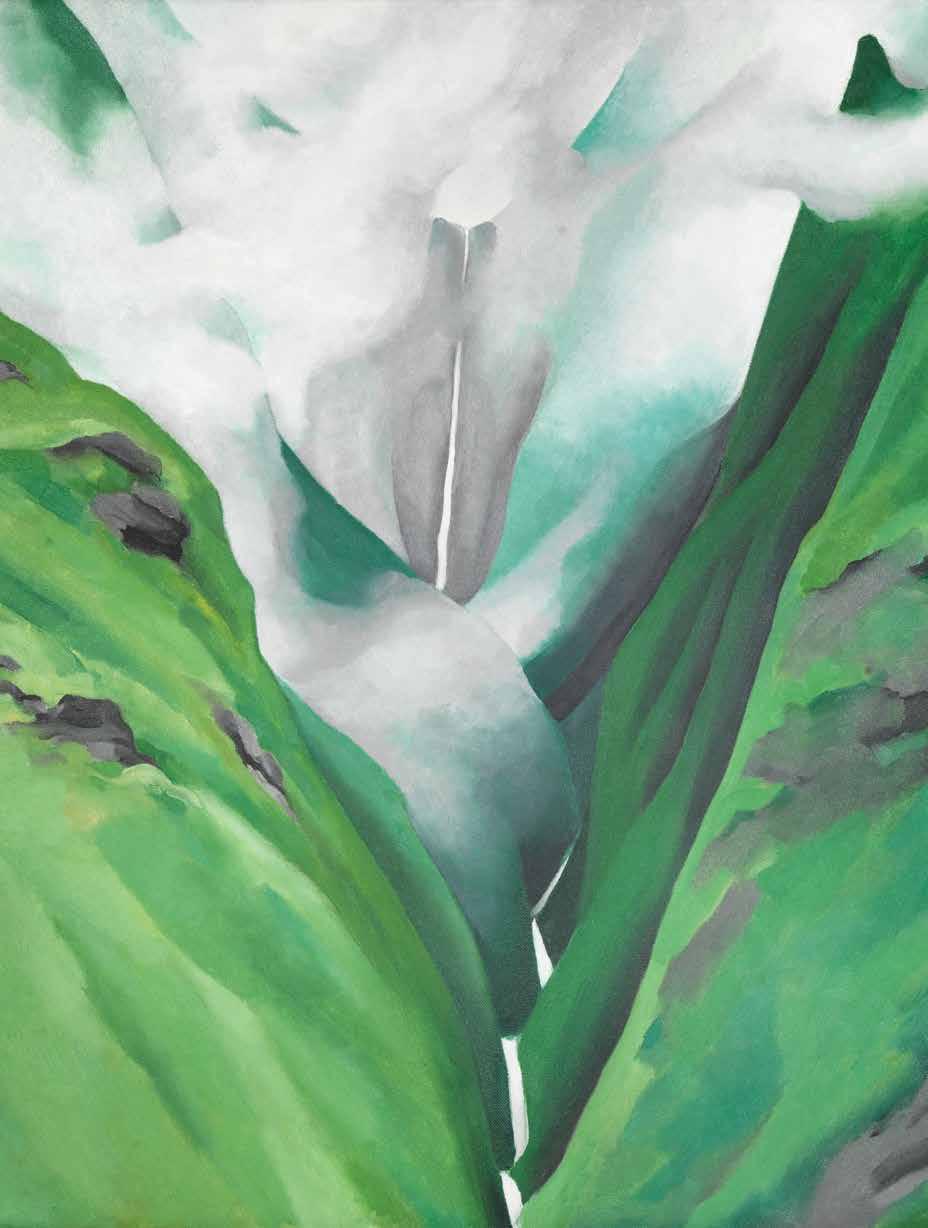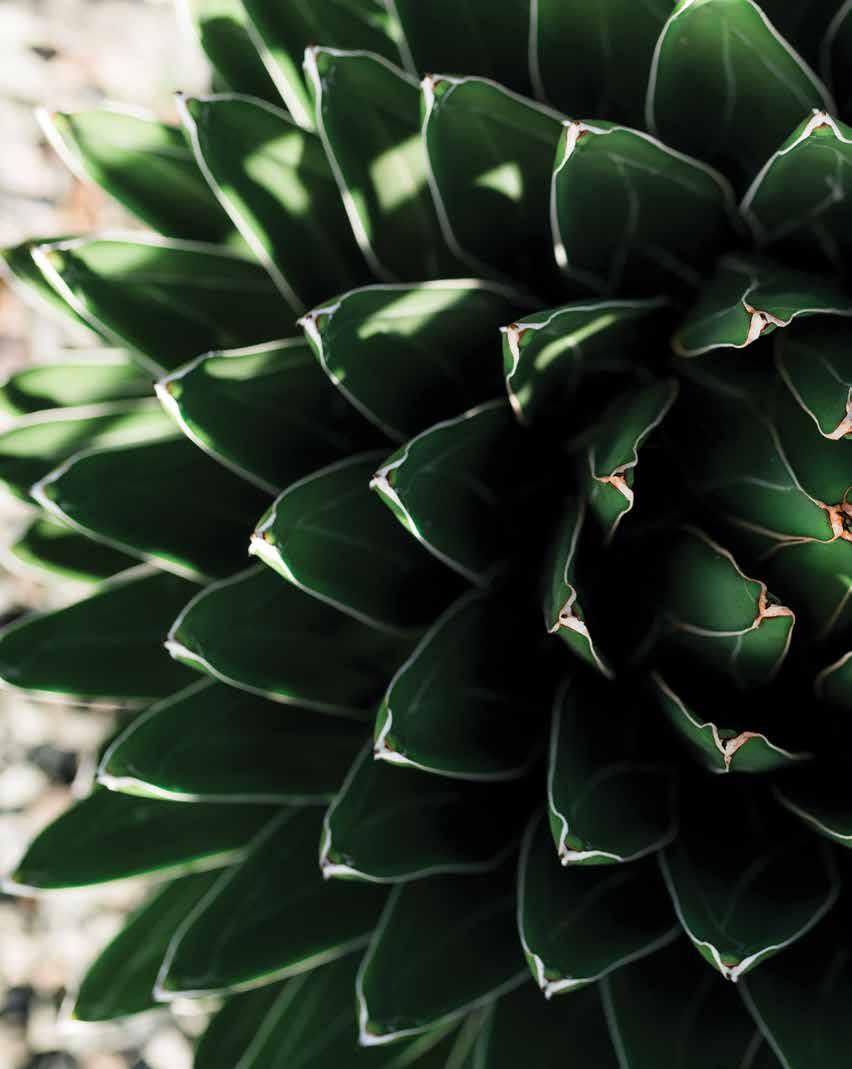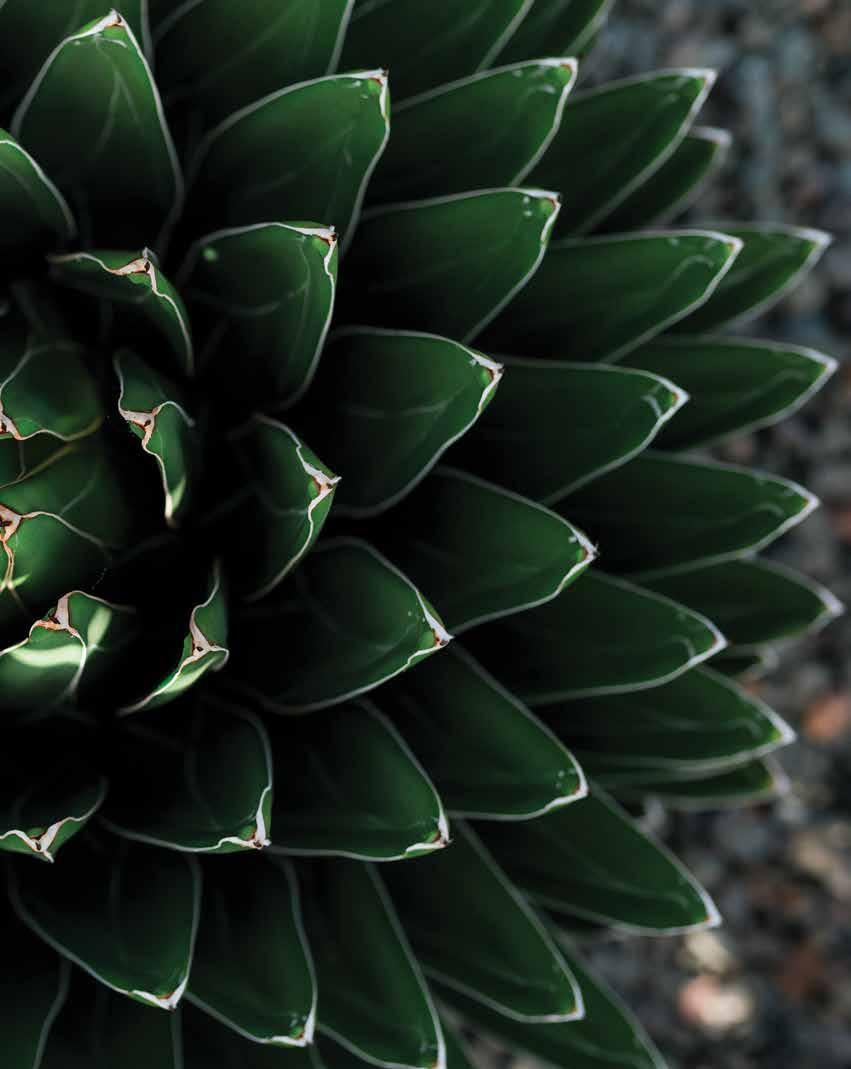General Manager
At Halekulani, we celebrate creativity and its power to transform into a legacy that endures through time. In this edition of Halekulani Living, we explore how creativity shapes the culture and communities around us, leaving an indelible mark on future generations.
This season, we meet three remarkable women who balance their professional careers with their artistic passions, working in diverse mediums such as leather, metal, and charcoal. We step into the serene gardens and courtyard of the Shangri La Museum of Islamic Art, Culture & Design, where aspiring filmmakers come together at the annual ‘Ohina Filmmakers Lab to share their work and inspire one another.
Then, we delve into the captivating history of Hawaiian heirloom jewelry, believed to have originated with a gold bracelet presented to Queen Lili‘uokalani by Queen Victoria during her Golden Jubilee in England in 1887. This gift is thought to have inspired a unique tradition among island women that continues today.
Next, learn the story of Kyuzo Toyama, commonly referred to as the father of Okinawan emigration, who successfully petitioned the Japanese government to allow Okinawans to immigrate to Hawai‘i in the late 1800s to seek a better life.
Continue your journey through history with a visit to the Hawai‘i State Archives, where you can relive Waikīkī’s early live music scene through its vast vinyl record collection—including albums recorded at Halekulani, which has long been a hub for local musicians.
In the forests of Tantalus and the valley of Wai‘anae, beauty thrives at the intersection of nature and family: in the generational home of an interior designer and in a thriving orchid business. And just as nature nurtures creativity, we find sanctuary at SpaHalekulani, where innovative “quiet technology” fosters deep relaxation, taking guests to new levels of recovery and restoration.
Please enjoy this issue of Halekulani Living. We hope it inspires you to uncover the creativity that surrounds you and the creativity within.
Warmly, Davide Barnes General Manager Halekulani
ハレクラニでは、時を超えて受け継がれる遺産を作り出す創造性、そし てその力を大切にしています。今号のハレクラニリビングでは、創造性 が私たちの周りの文化やコミュニティをどのように形づくり、次世代へ の足跡として残していくのかを探ります。
今回は、プロフェッショナルなキャリアを持つ一方で、革、 金属、木炭といった、さまざまな素材を使い芸術への情熱を追求する 3人の素晴らしい女性を特集しています。また、意欲的な映画制作者た ちが集い、作品を通じて互いに刺激を与え合う毎年恒例の「オヒナ フィルム メーカーズ ラボ」の会場である「シャングリラ・イスラム文化 博物館」の閑静な庭園や中庭にも足を運びました。
さらに、1887年にリリウオカラニ女王が、英国で開催されたヴィ クトリア女王の即位50周年記念式典に出席した際に、ヴィクトリア女 王から贈られたゴールドのブレスレットに端を発する、ハワイアン エア ルーム ジュエリーの魅力的な歴史にも迫ります。この贈り物がハワイの 女性たちを触発して独自のジュエリー文化が生まれ、今日まで脈々と受 け継がれているのです。
続いては「沖縄移民の父」として知られる當山久三の物語を紐解 きます。1800年代後半に、より良い生活を求めてハワイへ移住するこ とを望む沖縄の人びとのため、當山は日本政府に働きかけ、尽力しま した 。
歴史の旅はまだまだ続きます。ハワイ州立公文書館では、膨大 なビニールレコードのコレクションに触れ、ワイキキの初期のライブ音 楽シーンを追体験。そのコレクションには、長年にわたり地元ミュージ シャンの拠点となってきたハレクラニで録音されたアルバムも含まれ ています。
タンタラスの森やワイアナエの渓谷では、自然と家族の営みが交 わる場所で、美が豊かに育まれています。それは、代々受け継がれてき たインテリアデザイナーの家や、成長し続けるオーキッド栽培のビジネ スのなかに息づいているのです。自然が創造性を育むように、スパハレ クラニでは心安らぐ場所をご提供しています。革新的な「静かなテクノ ロジー」が深いリラクゼーションを促し、新たなレベルの癒しと回復を もたらします。
ハレクラニリビングの最新号をお楽しみください。皆さまの周り に息づく創造性、そしてご自身の内に秘められた創造力を引き出す一助 となれば幸いです。
心を込めて ハレクラニ 総支配人 デイビッド バーンズ
Davide Barnes
ALA MOANA CENTER
ROYAL HAWAIIAN CENTER
JEWELS THAT TELL TIME
HALEKULANI CORPORATION
CHIEF OPERATING OFFICER
PETER SHAINDLIN
CHIEF EXECUTIVE ADVISOR
PATRICIA TAM
GENERAL MANAGER, HALEKULANI
DAVIDE BARNES
DIRECTOR OF SALES & MARKETING
LISA MATSUDA
HALEKULANI.COM
1-808-923-2311
2199 KALIA RD. HONOLULU, HI 96815
CHIEF EXECUTIVE OFFICER
JASON CUTINELLA
GENERAL MANAGER, HAWAI‘I
JOE V. BOCK
JOE@NMGNETWORK.COM
EDITORIAL DIRECTOR
LAUREN MCNALLY
MANAGING DESIGNER
TAYLOR NIIMOTO
PUBLISHED BY
NMG NETWORK
41 N. HOTEL ST. HONOLULU, HI 96817
NMGNETWORK.COM
SALES@NMGNETWORK.COM
© 2025 by NMG Network, LLC. All rights reserved. No part of this publication may be reprinted without the written consent of the publisher. Opinions are solely those of the contributors and are not necessarily endorsed by NMG Network.
Volume 17.1 Spring / Summer 2025
Interior designer Ginger Lunt’s mountain home is both a special project and personal sanctuary.
インテリアデザイナー、 ジンジャー・ラントさんの 山あいの家は、彼女の スペシャル・プロジェクトで あり心の拠り所でもある。
From Script to Screen
The Multi-Hyphenates CULTURE
A Gilded Legacy
Chords to the Past
Hope and Hardship DESIGN 84
A Haven on the Hill WELLNESS
Serenity Through Sound EXPLORE
The Business of Blossoms
ABOUT THE COVER:
Local creatives convene at the Shangri La Museum of Islamic Art, Culture & Design for the 2024 ‘Ohina Filmmakers Lab.
シャングリラ・イスラム文化博物館 で開催された2024 オヒナ フィルム メーカーズ ラボに参加した 地元ハワイのクリエイターたち。
Nicole Parente-Lopez’s frequent walks along O‘ahu’s coastlines inspired her to begin a foray into charcoal sketching of lava rocks. Get a glimpse into the artist’s seaside-to-studio process on Living TV.
At SpaHalekulani, “quiet technology” provides guests with new methods of relaxation.
スパハレクラニが提案する 「静かなテクノロジー」を 用いた新しいリラクゼーション。
TABLE OF CONTENTS
目次
ABOUT THE COVER: 表紙について:
ARTS 22
脚本からスクリーンへ 34
二刀流の生き方 CULTURE 52
受け継がれる金色の輝き 62
過去への調べ 70
希望と試練の狭間で DESIGN 84
丘の上のオアシス
Leather artisan Samantha Hook creates bespoke pieces inspired by the patterns she sees in nature.
革職人のサマンサ・フックさんは 自然が生み出すパターンから インスピレーションを得て、 オーダーメイド作品を制作している 。
オアフ島の海岸沿いを歩くうちに創作意欲を掻き立てられたニコル·パレンテ=ロペスさんは、溶岩石を描く木炭 スケッチを始めました。海岸での体験がアトリエでの制作に至る過程はリビングTVでご覧いただけます。
WELLNESS 100
音が織りなす静寂 EXPLORE 110
花のある仕事
LEARN MORE
Living TV is designed to complement the understated elegance enjoyed by Halekulani guests, with programming focused on the art of living well. Featuring cinematic imagery and a luxurious look and feel, Living TV connects guests with the arts, style, and people of Hawai‘i. To watch all programs, tune into channel 2 or online at living.halekulani.com.
客室内でご視聴いただけるリビング TVは、ハレクラニならではの上質な寛 ぎのひとときをお過ごしいただくため、 豊かで健康的なライフスタイルをテー マにしたオリジナル番組をお届けして います。臨場感溢れる映像で芸術やフ ァッション、食文化、ハワイの人々につ いてのストーリーをお楽しみください。 すべての番組は、2チャンネルまたは living.halekulani.com からご視聴 いただけます。
watch online at: living.halekulani.com
FROM SCRIPT TO SCREEN
脚本からスクリーンへ シャングリラ・イスラム文化博物館に、 コラボレーションや創造性そしてコミュニティを大切にする 意欲的な映画制作者たちが集まった。
At the Shangri La Museum of Islamic Art, Culture & Design, aspiring filmmakers gather in celebration of collaboration, creativity, and community.
THE BUSINESS OF BLOSSOMS
花のあるビジネス
While tending to blooms of myriad shape and hue, an orchid grower nurtures his family legacy.
色とりどりの花の手入れをしながら、オーキッド栽培家は 家族の伝統を継承してゆく。
CHORDS TO THE PAST
過去から未来への調べ
At the Hawai‘i State Archives, community-driven efforts ensure Hawai‘i’s music is preserved for future generations.
ハワイ州立公文書館では、コミュニティ主導の下、ハワイアン 音楽を後世に残す取り組みが行われている。
THE MULTI-HYPHENATE
二刀流の生き方
Inspired by walks along the coast, an artist honors the landscape and culture of her island home.
海辺の散歩からインスピレーションを得たアーティストが、 島の風景と文化を作品に刻む
A GILDED LEGACY
受け継がれる金色の輝き
For island women, Hawaiian gold jewelry is a beloved tradition symbolizing love and cultural legacy.
島の女性が受け継ぐ、愛と文化の継承を象徴する ハワイアンゴールドジュエリー
BY
TEXT
LINDSEY VANDAL
BY
IMAGES
MICHELLE MISHINA
文=リンジー・ヴァンダル
写真=ミシェル・ミシナ
The Shangri La Museum of Islamic Art, Culture & Design hosted the ‘Ohina Labs filmmaker workshop in Fall 2024.
シャングリラ イスラム文化博物
館では、2024年秋にオヒナ ラボ のフィルムメーカー向けワーク ショップが開催された。
FROM SCRIPT TO SCREEN
脚本からスクリーンへ
TRANSLATION BY KYOKO HAMAMOTO
訳:濱元恭子
Hawai‘i’s next generation of filmmakers converge at Shangri La to learn from masters of visual storytelling.
ハワイの次世代映画制作者たちがシャングリラで映像界の大家と共有する学びの時間
Perched atop a rocky bluff on O‘ahu’s southeastern coastline, offering picturesque ocean vistas and a pervasive sense of calm, the Shangri La Museum of Islamic Art, Culture & Design is a vortex of creative energy. Built in 1937 with a blend of coral, stone, teak, tile, and marble, the museum’s aesthetic and the artifacts within reflect former resident Doris Duke’s fascination with emblems of cultural identity. Home to more than 2,500 artworks and relics from Duke’s travels across North Africa and Asia, the estate features elegant decor and landscaping, a serene central courtyard and playhouse, and a Persian design-influenced lap pool. Here, architecture, art,
オアフ島南東部の海岸線に突き出した岩場の上に佇む「シャングリラ イスラム文化博物館」は、絵画のように美しい海の景観と心安らぐ穏や かな静けさに包まれている。ここはまた、クリエイティブパワーが渦巻く 神秘的な空間でもある。1937年に建てられたこの博物館は、サンゴ、 石材、チーク材、タイル、大理石といった素材が用いられ、当時の住人で あったドリス・デュークが抱いた文化的アイデンティティへの情熱を反 映している。デュークが北アフリカやアジアを巡る旅で蒐集した2,500 点以上の美術品や遺物が展示されているのだ。洗練された装飾や庭 園、静寂な中庭とプレイハウス、ペルシャ風デザインのプールなどが、 この邸宅の魅力をさらに引き立てている。ここでは建築、芸術、文化、
“The time to experiment is now,” says ‘Ohina executive director Gerard Elmore on the local filmmaking scene.
ハワイの映画制作の現状
について、オヒナのエグゼク ティブ・ディレクターを務め
るジェラード・エルモアさんは 「今こそ、やってみる時なの です」と述べる。
culture, and environment intersect, creating the perfect space for the storytelling mind to inhabit.
Joining the artists and musicians long drawn to Shangri La’s gravitational pull was a recent cohort of Hawai‘i’s movie-making talent, who gathered at the private estate for the 2024 ‘Ohina Labs filmmaker workshop this past fall. The event, held over two Saturdays, paired 10 aspiring auteurs with three accomplished ‘Ohina alumni: Ty Sanga, director of the Emmy-winning food travel series Family Ingredients; Chris Kekaniokalani Bright, co-writer for Disney’s live-action adaptation of Lilo & Stitch; and Zoë Eisenberg, director of the recent Slamdance selection Chaperone.
In the hallowed spaces of Shangri La, invitees found moments of creative reflection amid lush gardens and winding water channels. In the estate’s playhouse, they received guidance on script development, pitching, and production from their mentors and peers and mingled with surprise guests: Henry Ian Cusick, Emmy-nominated actor from the ABC television series Lost, and Stephen Brouchard,
そして自然が一体となり、物語を紡ぐ心が宿るのにふさわしい空間を 生み出している。
シャングリラの魅力に引き寄せられるアーティストや音楽家に 混じり、映画制作に携わる人々がここに集結した。昨秋、2024年の映 画制作ワークショップ「オヒナ ラボ」が2週に亘って土曜日に開催さ れ、10人の若手映画制作者が、映画界で活躍する「オヒナ」卒業生3人 と一緒になり、学びの時間を共有した。メンターとして招かれたのは、エ ミー賞受賞のフードトラベルシリーズ『ファミリー・イングリディエンツ』 の監督であるタイ・サンガさん、ディズニーの実写版『リロ&スティッチ』 の共同脚本家のクリス・ケカニオカラニ・ブライトさん、そしてスラムダ ンス映画祭選出作品『シャペロン』を監督したゾーイ・アイゼンバーグ さんら、実績と才能に満ちた3名の映画製作者たちである。
シャングリラの神聖な空間で、参加者たちは緑美しい庭園と水の せせらぎの中に身を置きながら、創造的な思索を深めるひとときを過ご した。敷地内のプレイハウスでは、メンターや他の参加者から脚本作り やプレゼンテーションのコツ、制作に関するアドバイスを受けたほか、 思いがけないゲストとの交流を深めた。今回サプライズで参加してくれた
‘Ohina is the Hawaiian word for “gathering.” Each year, the lab brings together aspiring filmmakers.
オヒナとはハワイ語で「集まり」を意味する。毎年、このラボには新進 気鋭の映画制作者が集まる。
vice president of production and development at Marvel Studios. At the end of the second Saturday, the screenwriting protégés pitched their islandinspired short film ideas before a panel of judges.
Reserved for filmmakers with a creative tie to Hawai‘i, the ‘Ohina Filmmakers Lab and Short Film Showcase have played a pivotal role in both supporting and amplifying local and Indigenous voices. The original ‘Ohina Showcase—named for the Hawaiian word for “gathering”— debuted in 1999 and ran for nearly a decade. In 2017, filmmakers Gerard Elmore and Darrin Kaneshiro revived the event and added the ‘Ohina Labs component. Similar to how Slamdance champions indie films outside of Sundance’s spotlight, the synergistic ‘Ohina events empower Hawai‘i’s visual storytellers, who may lack access to the resources and connections needed to elevate their stories from script to screen.
“I don’t think a lab exists anywhere else in the world where you have this incredible museum right on the ocean and a retreat-style backdrop,” says Elmore, who currently serves as ‘Ohina’s executive director. “Seven years and 26 films later, here we are at Shangri La, building something that feels like a Sundance lab, with the arts community going all in ... That makes it special.” Though 2024 marks the first ‘Ohina Labs hosted by Shangri La, Elmore hopes the glowing success of the event will lead to ongoing collaboration.
Closing out the final ‘Ohina Labs session, Samoan American writer Anette Arinix was awarded the Green Light Award for her script Kama‘āina Not Kanaka, which explores the deeper meaning of a cherished song between two best friends. Looking back on her “surreal” Shangri La experience, Arinix explained that being surrounded by art rooted in diverse communities and cultures inspired her to reflect on the unique challenges local and Indigenous creatives face: “Hawai‘i mirrors this complexity, with countless layers beneath the surface. Some of our stories don’t fit neatly into a polished narrative, but they matter. It’s vital to honor and acknowledge these stories that explain how we arrived here, how we continue to endure, and how we’re building a foundation for those who will come after us.”
As part of the Green Light award, Arinix receives up to $20,000 in production support and a commitment from the ‘Ohina team to help Kama‘āina
のは、ABCテレビシリーズ『LOST』でエミー賞にノミネートされた俳優 のヘンリー・イアン・キュージックさんとマーベル スタジオ制作開発部 門担当副社長のスティーブン・ブロシャードさんだ。そしてワークショッ プ最終日には、脚本家を目指す参加者たちが、ハワイをテーマにした短 編映画の構想を審査員の前で発表することになった。
クリエイティブな作品制作において、ハワイと縁のある映画製作 者のために設けられた『オヒナ フィルム メーカーズ ラボ』と『ショート フィルム ショーケース』は、地元や先住民の声を支え、その存在感を高 める上で重要な役割を担っている。「オヒナ」とはハワイ語で「集まり」を 意味し、1999年に初めて開催された短編映画の上映は10年近く続い た。2017年には、映画製作者のジェラード・エルモアさんとダリン・カ ネシロさんがこのイベントを復活させ、その際にオヒナ ラボを新たに加 えた。サンダンス映画祭で注目を浴びないインディーズ映画を支援する スラムダンス映画祭のように、「オヒナ」の取り組みもまた、資金や援助、 人脈に恵まれないハワイの映像クリエイターたちを後押ししている。
「海辺にそびえる壮麗な美術館と静養所のような静寂に包まれ た環境を兼ね備えたラボは、世界中を探してもここだけでしょう」と語る のは、「オヒナ」の現エグゼクティブ ディレクターでもあるエルモアさん だ。「7年間で26本の映画を制作し、ここシャングリラで、サンダンスラ ボのような体験を共有し、地元のアートコミュニティが全力で関わって くれている。これこそが、この場を特別なものにしているのです」。2024 年、シャングリラで初めてオヒナ ラボが開催された。その成功を受けて、 今後の継続的なコラボレーション活動をエルモアさんは期待している。
オヒナ ラボの最終セッションの締めくくりでは、サモア系アメリ カ人作家のアネット・アリニクスさんが手がけた脚本『カマアイナ ノット カナカ』がグリーンライト賞を受賞した。この作品は、2人の親友が大切 にしていた一曲の歌に秘められた真意を探る物語だ。シャングリラでの 体験を「まるで現実と夢の狭間にいるようでした」と振り返るアリニクス さん。多様なコミュニティや文化に根ざした芸術に囲まれる中で、地元 や先住民のクリエイターが直面する個々の課題についてあらためて考 えさせられたと話す。「ハワイには、目に見える表層の下に、幾重にも重 なる文化や歴史の層が存在しています。私たちの物語には、きれいに物 語としてまとめられないものもありますが、どれにも大切な意味があり ます。私たちがどのようにここに至り、どのように生き抜いて耐え続け、 そして未来のためにどのような土台を築いているのかを伝えることは何 よりも重要なことです」
グリーンライト賞の副賞として、最大2万ドルの制作支援を受け るアリニクスさんは、オヒナチームの全面的なサポートのもと、『カマア イナ ノット カナカ』を完成させ、2025年の『オヒナ ショーケース』で初
Anette Arinix won the Green Light Award for her script Kama‘āina Not Kanaka, which explores the deeper meaning of a song between two best friends.
Halekulani, a partner of the Hawai‘i International Film Festival, is a champion of diverse art forms throughout the state. Short films honed during the ‘Ohina Filmmakers Lab are often selected to screen at HIFF and festivals worldwide.
ハワイ国際映画祭のパート ナーであるハレクラニは、ハワ イの豊かな芸術文化を支援 している。オヒナ フィルムメー カーズ ラボでレベルアップした 短編映画は、ハワイ国際映画祭 や世界各地の映画祭でたびた び上映されている。
Not Kanaka reach completion, with the goal of debuting the film during the 2025 ‘Ohina Showcase. “I’ve made magic on nothing but passion and plate lunch, and now I have a bit more to dream with,” Arinix adds. “This effort is not mine alone. I have been blessed with a wonderful village of people, and we are going to make sure all of our stories are told.”
上映することを目指している。「これまで、情熱とプレートランチだけで 作品を作り続けてきました」。資金的な苦境に立たされていたアリニク スさんだが「もう少しだけ大きな夢を見れるようになりました」と感謝の 思いを語った。「私一人の努力ではありません。多くの素晴らしい仲間た ちに恵まれたおかげです。必ず、われわれ全員の物語を伝えていきます」
Fashion. Dining. Culture.
from day to night
SUN UP TO SUN DOWN, THERE’S MAGIC AROUND EVERY CORNER.
FROM
Harry Winston | Valentino | Hermès | Fendi | Tiffany & Co. | Rimowa | Moncler | Ferragamo | Saint Laurent
Kahala | KITH | Moncler | Stüssy | Tory Burch | Yumi Kim | Rock-A-Hula | Doraku Sushi | Island Vintage Wine Bar
Noi Thai Cuisine | Restaurant Suntory | P.F. Chang’s | The Cheesecake Factory | Tim Ho Wan | TsuruTonTan Udon
Wolfgang’s Steakhouse | Partial Listing
TEXT BY LINDSEY VANDAL
IMAGES BY JOHN HOOK
文=リンゼイ・ヴァンダル
写真=ジョン・フック
THE MULTI-HYPHENATES
二刀流の生き方
Crystal DeRosier’s artistic endeavors reflect themes of self-discovery.
クリスタル・デロジエさん
の芸術活動は、自己探求 の旅を映し出す。
TRANSLATION BY MUTSUMI MATSUNOBU ARTS
訳:松延むつみ
Working in mediums of leather, metal, oil, and charcoal, three O‘ahu artists embrace artistic identities beyond their successful creative careers.
革、金属、油彩、木炭といった多彩な素材を使って創作するオアフ島在住の3人のアーティスト。キャリアにとらわれない、輝かしくクリエイティブな 芸術的アイデンティティの探求
Crystal DeRosier
Marketer, metalsmith, mixed-media artist
While studying art at California State University, Fullerton, Crystal DeRosier oversaw entertainment operations at Disneyland Resort in Anaheim, California, before transitioning to Walt Disney Studios in Los Angeles. There, she designed movie premieres, traveling exhibits, and themed events, including a Halloween transformation of the White House.
クリスタル・デロジエ
マーケティング担当者、金属細工師、ミクストメディア・アーティスト クリスタル・デロジエさんは、カリフォルニア州立大学フラトン校で美術 を学ぶかたわら、同州アナハイムのウォルトディズニー スタジオで日々 の運営管理を担当していた。その後ロサンゼルスのウォルトディズニー スタジオに異動。そこでは、映画のプレミアイベントや巡回展、ホワイト ハウスのハロウィーン仕様の演出など、テーマイベントのデザインに携 わるようになる。
“It was an incredible experience that fulfilled so many creative dreams, but the demanding pace eventually took its toll,” DeRosier reflects. After healing from multiple surgeries and navigating life changes, DeRosier relocated to Hawai‘i in search of a fresh start. In 2018, she stepped into the role of marketing manager for Halekulani, a position that allowed her to flex her photography and design skills. Outside of work, she reconnected with her personal artistic practice, experimenting with watercolor painting and sculptural forms.
DeRosier met renowned Hawai‘i artist Satoru Abe while covering his exhibit for a Halekulani gallery feature. Abe encouraged her exploration of metalsmithing, suggesting she start with the more accessible scale of jewelry making. “He let me try cutting metal for the first time at the bench he brought to the show,” DeRosier recalls, an experience that sparked something within her. “I fell in love.”
Motivated by Abe’s advice to pursue dual disciplines of painting and metalsmithing, DeRosier immersed herself in art, taking oil painting classes from artist Nathaniel Evans and binge-watching jewelry-making videos online. In 2021, she debuted her first jewelry collection, followed by another collection, Coral Dreams, which was featured in a 2023 exhibit at Ghost Gallery in Seattle. That same year, she showcased new oil paintings in group shows at Mori by Art + Flea, Manini Gallery, and collaborated with artist Lauren Hana Chai on a special jewelry collection for the Honolulu Museum of Art.
At present, DeRosier is preparing Sacred Darkness, an oil painting series that delves into themes of inner transformation and self-discovery. “There are still a lot of moody browns and darkness, but more greenery is emerging,” she hints. “The vibrancy mirrors the growth I’m experiencing in my life right now.”
「多くの創造的な夢が叶えられた素晴らしい経験でしたが、過 酷なペースでの働き方がやがて心身の負担となってしまいました」と デロジエさんは振り返る。何度もの手術を経て回復し、人生の転機を 乗り越えたデロジエさんは、新たなスタートを求めてハワイに移住す る。2018年にハレクラニのマーケティング マネージャーに就任し、写 真とデザインのスキルを活かせることになった。仕事以外では、水彩画 や彫刻に取り組み、創作活動も再開した。
デロジエさんがハワイの著名なアーティストであるサトル・アベさ んに出会ったのは、ハレクラニギャラリーの特集で彼の展覧会の記事 を担当したときのことだった。アベさんは彼女に金属細工への挑戦を勧 め、より身近なジュエリー制作から始めてみてはどうかと助言した。「ア ベさんが展覧会に持ち込んだ作業台で、私は初めて金属を切断したの です」とデロジエさんは回想する。この経験は彼女の創作への情熱に火 をつけた。「私は一瞬で心を奪われてしまいました」
絵画と金属細工の両分野を学んでみてはというアベさんの助言 に意欲をかき立てられたデロジエさんは、アーティストのナサニエル・ エヴァンスさんから油絵を学び、オンラインでジュエリー制作のビデオ を繰り返し見て、芸術の世界に深く没頭した。2021年には、初のジュエ リーコレクションを発表。続いて発表したコレクション「コーラル ドリー ムス」は、2023年にシアトルの「ゴースト ギャラリー」で展示された。同 年、デロジエさんは「モリ バイ アート + フリー」のグループ展で新作の 油絵を発表し、さらにアーティストのローレン・ハナ・チャイさんと共同 で、ホノルル美術館の特別ジュエリーコレクションの制作を手がけた。
現在、内面の変化と自己発見というテーマを掘り下げた油絵シ リーズ「Sacred Darkness(神聖な闇)」を制作中のデロジエさん。「ま だ、もの悲しげな茶色と暗い色が主ですが、少しずつ緑色も増えてきて います」とほのめかす。「この活力ある変化は、まさに今の私が人生にお いて経験している成長そのものを反映しています」
Encouraged by Hawai‘i icon Satoru Abe, DeRosier explored metalsmithing to further channel her creative energy.
In her studio in Chinatown, Samantha Hook crafts artisanal leather goods.
チャイナタウンにある工房 で、サマンサ・フックさんは、
匠の技を駆使して革で作品 を制作している。
Samantha Hook
Photo editor, leather artisan
In 2019, O‘ahu-born photo editor Samantha Hook spotted a leather zipper clutch that a friend was wearing and felt compelled to make one herself. After studying a few YouTube tutorials, she crafted her first accessory—a clutch made from a deconstructed aloha shirt, lined with faux leather. Inspired to do more, she began experimenting with veg-tan leather, cowhide treated with natural tannins. Although Hook had a rewarding freelance career editing wedding photos alongside her photographer husband, leathercrafting filled a creative void. According to Hook, the whole process felt cathartic.
As her handmade handbags gained fans, Hook built Tidal Theory, a brand centered around leatherworking. In June 2024, she joined a collaborative studio space in Chinatown and began consigning her wares at the retail shop, Open Sea Leather, located below. The shop’s owner, Michael Bluth, became a mentor. “As my craft evolved, the pieces looked cleaner and sharper,” Hook recalls. “When I could admit to people that I made them, and then when Michael invited me to join the shop, that’s when I knew I was all in.”
Hook’s style is marked by an interplay of geometric shapes, with signature pieces, like the Half Moon Clutch and Single Fin Belt Pouch, taking inspiration from her love of surfing and nature. During the 2024 Christmas season, her circular Hali Bag with a half-moon handle was featured in Etsy’s holiday pop-up event in New York City. Recently, Hook’s interest in sustainable sourcing has expanded her materials to include fish leather, crafted by preserving the skin of mahimahi, salmon, and ta‘ape using tannins from black tea and kiawe bark. Though photo editing remains her first love, Hook is excited to see how far she can take Tidal Theory. She joined Open Sea Leather as a partner and is gearing up for a build-out of its new location on Nu‘uanu Street, set to open in spring of 2025.
To this day, Hook stitches every piece by hand. “My mind goes quiet, and I’m at peace when I’m working with the leather,” she says. “I think it shows that there’s a lot of care and thought that goes into what I make.”
サマンサ・フック 写真編集者、革職人
オアフ島生まれの写真編集者であるサマンサ・フックさんが、友人が 持っていた革製のジッパー付きクラッチバッグを見て、どうしても自分で 作ってみたいと思ったのは2019年のことだった。YouTubeのチュート リアルをいくつか見て勉強した後、最初に手がけたのは、バラバラに切っ たアロハシャツを使って合成皮革の裏地をつけたクラッチバッグだっ た。創作意欲に火がついたフックさんは、天然タンニンでなめしたベジタ ン革と呼ばれる牛革を使った作品作りを始める。写真家の夫とともに、 結婚式の写真編集を手がけるフリーランスの仕事に充実を感じていた フックさんだが、革クラフトは彼女に新たな創造性の場をもたらした。そ のプロセスすべてに精神の浄化を感じたのだと、彼女は説明する。
彼女が手作りするハンドバッグのファンが増えてくると、フック さんは革製品を中心としたブランド「ダイダル セオリー」を立ち上げ る。2024年6月、チャイナタウンにある共同スタジオスペースに拠点を 構えたフックさんは、階下の小売店「オープン シー レザー」で作品の委 託販売を始めた。店主のマイケル・ブルースさんが、彼女の指導者となっ てくれた。「技術が向上するにつれ、作品もよりきれいでシャープに仕上 がるようになりました」とフックさんは回想する。「自分で作った作品だ と胸を張って言えるようになり、さらにマイケルさんが委託販売に誘っ てくれたとき、私は全力で取り組む覚悟を決めました」
フックさんの作品スタイルは幾何学的な形状の組み合わせが特 徴で、「ハーフムーンクラッチ」や「シングルフィン ベルトポーチ」などの 代表作は、彼女が愛するサーフィンや自然からインスピレーションを得 たものだ。2024年のクリスマスシーズンには、グローバルオンライン マーケットのEtsyが、ニューヨーク市にて開催したホリデーポップアッ プイベントで、半月型の持ち手が付いた円形の「ハリ バッグ」を紹介し た。最近、持続可能な素材に興味をもっているフックさんは、マヒマヒや サーモン、ヨスジフエダイといった魚の皮を、紅茶やキアヴェの樹皮か ら抽出したタンニンでなめした魚革も使っている。
フックさんにとって、写真編集は今でも一番好きな仕事であるこ とに変わりはないが、「ダイダル セオリー」の可能性をどこまで広げられ るのかということにも、大きな期待を寄せている。現在は「オープン シー レザー」にパートナーとして携わって、2025年春にヌウアヌ通りにオー プン予定の新店舗の立ち上げの準備を進めている。
現在もフックさんはすべての作品を手縫いで仕上げている。「革 を使って作品を作っていると、心が穏やかになり、安らかな気持ちにな るのです」と語る。「私が作るものには、細部へのこだわりや思いが宿っ ているとわかってもらえると思います」
“My mind goes quiet, and I’m at peace when I’m working with the leather.”
—Samantha Hook, photo editor and leather artisan
「革を使って作品を作っていると、心が穏やかになり、安らかな気持ちになるのです」サマンサ・フック、フォトエディター兼革職人
Nicole Parente-Lopez’s
charcoal sketches are an exquisite exercise in texture and topography.
ニコール・パレンテ=ロペス さんの木炭画は、質感と地形 を巧みに表現した作品だ。
Nicole Parente-Lopez: Creative executive, charcoal artist
In April of 2024, Nicole Parente-Lopez reached an inflection point that would shift her focus from creating in service of others to exploring her own personal passions. After nearly a decade as a creative executive for a global tech company and 15 years prior in the design industry, she announced a sabbatical. Her commute to the San Francisco Bay Area from Honolulu, where she and her husband had recently moved to be closer to his family, left her torn between two worlds, and it was time for a reset.
Seeking connection with her new island home, Parente-Lopez took long walks along O‘ahu’s southeastern coastline, visiting Sandy Beach and Makapu‘u and marveling at the terrain shaped by ancient lava flows and erosion. “When you walk far enough down, it’s just lava everywhere,” she notes. “The fact that this lava gave us the land, and everything we’re able to enjoy here, is just incredible. I’m drawn to that story.”
She soon began photographing the volcanic formations, often returning at different times of the
ニコール・パレンテ=ロペス クリエイティブ エグゼクティブ、木炭画家 2024年4月、ニコール・パレンテ=ロペスさんは、他者のための創造か ら自身の情熱の探求へと視点を移す転換のときを迎える。世界的なテ クノロジー企業のクリエイティブ エグゼクティブとして10年近く、さら にデザイン業界で15年のキャリアを積んだ後、パレンテ=ロペスさんは 長期休暇を取ることを発表した。夫の家族の近くに住むために、最近夫 婦でホノルルに引っ越してきたが、ホノルルからサンフランシスコのベイ エリアまでの通勤は、彼女を2つの世界に引き裂いた。そのような状況 をリセットする時期が来ていたのだ。
新たな棲家となった島とのつながりを求め、サンディビーチやマ カプウなどオアフ島南東部の海岸沿いを長時間歩いたパレンテ=ロ ペスさんは、太古の溶岩流と浸食によって形成された地形に驚嘆した。 「かなり奥へと歩みを進めると、どこもかしこも溶岩だらけなのです」と 話す。「この溶岩が土地だけでなく、ここで私たちが享受しているすべて の基盤になっているなんて、本当に驚くべきことです。私はその物語に強 く心惹かれるのです」
火山が創り出した地形を写真に撮り始めたパレンテ=ロペスさん は、一日に何度も同じ場所に戻り、自然光が風景にもたらすさまざまな
With its complex configurations, a lava-rock drawing can take Parente-Lopez up to several weeks to complete.
その複雑な構成のために、パレンテ=ロペスさんが溶岩画を完成させ るには数週間を要することもある。
day to witness the varying effects of natural light on the landscape. Zooming in on digital images of her favorite rocks, she started hand-sketching the figures, section by section, reinterpreting every detail on charcoal paper with extra-soft charcoal pencils, “because they make the richest, deepest blacks,” she adds.
Each lava-rock drawing can take between 10 days to three weeks to complete, or even longer for more complex configurations. “It’s an emotional journey with some of them,” Parente-Lopez says, describing how the initial sketch often appears flat and two-dimensional. “As I get deeper into it, intense shadowing and depth start to emerge.”
With no plans to return to corporate life just yet, Parente-Lopez is enjoying the flow of an unscripted life fueled by creative energy. She envisions staging her first charcoal drawing exhibition in 2025 to share the profound impact Hawaiian culture and geology have had on her life. “I want people to feel the weight of the rocks—the way I feel when I look at them all together,” she says. “They’re kind of like the wise elders of these moments.”
効果を観察した。そして、お気に入りの岩のデジタル画像を拡大しては、 木炭紙に極軟質の木炭鉛筆を使って、細部まで綿密に再現したスケッ チを描き始めた。「木炭鉛筆を使うのは、とても豊かで奥行きのある黒 を表現できるからです」と付け加える。
溶岩の絵は、完成までに10日から3週間ほどかかるが、より複雑 な構成の場合はさらに長い時間が必要となる。「作品によっては、感情 が揺れ動くことがあります」とパレンテ=ロペスさんは語る。そして、最 初のスケッチは平面的で二次元的に見えることが多いが、「作品に没頭 していくにつれ、濃密な陰影や奥行きが徐々に浮かび上がってくるので す」と説明する。
今のところ企業勤めに戻る予定はなく、創造的なエネルギーに 導かれるままに、予定に縛られることのない自由な生活の流れを楽し んでいるというパレンテ=ロペスさん。ハワイの文化と地質が彼女の人 生に与えた深い影響を伝えるため、2025年には初の木炭画展を開こ うと構想を練っている。「私がどこまでも続く溶岩を眺めたときに感じ る岩の重みを、作品を見た人にも同じように感じてもらいたいのです」 と語る。「溶岩は、この瞬間のために存在する、知恵を宿した長老のよ うなものです」
Parente-Lopez’s walks along O‘ahu’s southeast shore provide endless inspiration for her works.
オアフ島南東部の海岸沿 いを歩きながら、パレンテ= ロペスさんは、作品制作に おける無限のインスピレー ションを得る。
Gather in the Company of Sea and Sky
Connect and share in a place that blends natural beauty, modern design, and gracious amenities, including sparkling pools for entertainment and wellness.
オアフの自然美を取り入れたモダンデザインと、細部にまでこだわり抜いた プールなどのアメニティの数々で、人々はつながり、分かち合う。
Studio, One, Two, and Three Bedroom Honolulu Residences ホノルルのスタジオ、1ベッドルーム、2ベッドルーム、3ベッドルームレジデンス
INQUIRE
thelauniuwardvillageliving.com | 808 470 6740 Offered by Ward Village Properties, LLC RB-21701
THE PROJECT IS LOCATED IN WARD VILLAGE, A MASTER PLANNED DEVELOPMENT IN HONOLULU, HAWAII, WHICH IS STILL BEING CONSTRUCTED. ANY VISUAL REPRESENTATIONS OF WARD VILLAGE, INCLUDING WITHOUT LIMITATION, RETAIL ESTABLISHMENTS, PARKS, AMENITIES, OTHER FACILITIES AND THE CONDOMINIUM PROJECTS THEREIN, INCLUDING THEIR LOCATION, UNITS, VIEWS, FURNISHINGS, DESIGN, COMMON ELEMENTS AND AMENITIES, DO NOT ACCURATELY PORTRAY THE CONDOMINIUM PROJECTS OR THE MASTER PLANNED DEVELOPMENT. ALL VISUAL DEPICTIONS AND DESCRIPTIONS IN THIS ADVERTISEMENT ARE FOR ILLUSTRATIVE PURPOSES ONLY. THE DEVELOPER MAKES NO GUARANTEE, REPRESENTATION OR WARRANTY WHATSOEVER THAT THE DEVELOPMENTS, FACILITIES OR IMPROVEMENTS OR FURNISHINGS AND APPLIANCES DEPICTED WILL ULTIMATELY APPEAR AS SHOWN OR EVEN BE INCLUDED AS A PART OF WARD VILLAGE OR ANY CONDOMINIUM PROJECT THEREIN. EXCLUSIVE PROJECT BROKER WARD VILLAGE PROPERTIES, LLC, RB-21701. COPYRIGHT ©2025. EQUAL HOUSING OPPORTUNITY.
WARNING: THE CALIFORNIA DEPARTMENT OF REAL ESTATE HAS NOT INSPECTED, EXAMINED OR QUALIFIED
TEXT BY KATHLEEN WONG
IMAGES BY JENN ELLENBURG, LAURA LA MONACA & NANI WELCH KELI‘IHO‘OMALU
文=キャスリーン・ウォング
写真=ジェン・エレンバーグ、
ローラ・ラ・モナカ、 ナニ・ウェルチ・ケリイホオマル
A GILDED LEGACY
受け継がれる金色の輝き
TRANSLATION BY MUTSUMI MATSUNOBU
翻訳=松延むつみ
For island women, Hawaiian gold jewelry is a beloved tradition symbolizing love and cultural legacy.
島の女性が受け継ぐ、愛と文化の継承を象徴するハワイアンゴールドジュエリー
When Halekulani hotel ambassador Melissa Mancao-Young enters a room, the soft, melodic jingling of her Hawaiian heirloom bracelets often precedes her arrival. On her wrists, the pair of gold bracelets gleam, rich with significance—a connection to not only her Hawaiian roots but also her family.
One bracelet, willed to her after her mother’s passing in 2008, serves as a cherished reminder of her late mother, while the other, engraved with her daughter’s name, Crishelle Kaleiohoku Young, is a piece she plans to pass down one day. “Wearing the heirloom jewelry keeps me close to my ‘ohana and keeps me grounded and centered in who I am,” Mancao-Young says. They symbolize a mother’s love as well as the spirit of her Hawaiian culture—one that endures from the uniting of the Hawaiian Islands to the Kingdom’s overthrow to today.
Hawaiian heirloom jewelry can be traced back to Queen Lili‘uokalani, Hawai‘i’s last monarch. As a princess, she is said to have received a gold bracelet from Queen Victoria at the Golden Jubilee in England in 1887. This gift, passed from one sovereign to another, sparked a cultural tradition among women in Hawai‘i, who often looked to ali‘i (royalty) for style inspiration. Over time, these bracelets became more than fine jewelry—they became symbols of love and heritage and are often passed down as treasured heirlooms. According to Mancao-Young, each piece holds significant meaning: “There is always a story behind it.”
Star Dahl-Thurston echoes the sentiment. “To me, heirloom bracelets have always symbolized a rite of passage—a cherished gift given to mark milestones and celebrate someone’s journey,” she says. “They embody tradition, love, and the enduring connections between generations.”
Dahl-Thurston holds two pieces dearly: one, a bracelet from her grandmother, resized for her upon her graduation from high school, and another, engraved with her name and crafted by Royal Hawaiian Heritage Jewelry to commemorate her title as Miss Hawai‘i 2023. “Each bracelet I wear inspires me to honor the legacy of the strong women they represent,” she says.
ハレクラニのホテル アンバサダーを務めるメリッサ・マンカオ=ヤングさ んが部屋に入ってくると、彼女が身につけているハワイアン エアルーム ジュエリーのブレスレットのやわらかく心地良い金属音が聞こえてくる。 彼女の手首には、2つの金色のブレスレットがきらめいている。それは、 ハワイのルーツだけでなく、家族との絆を映し出す大切なものだ。
ひとつは2008年に母親が亡くなった時に遺言によって受け 継いだもので、亡き母を偲ぶ大切な思い出の品である。「Crishelle Kaleiohoku Young」と愛娘の名が刻まれたもうひとつのブレスレット は、いつの日か娘へと託すつもりだ。「母から受け継いだハワイアン エア ルーム ジュエリーを身につけていると、オハナ(ハワイ語で「家族」の意) を身近に感じられ、自分を見失わずにいられるのです」と語るマンカオ= ヤングさん。こういったジュエリーは、母の愛の象徴であると同時に、 ハワイ諸島の統一から王国の転覆を経て、今日まで受け継がれてきた ハワイ文化の精神を体現するものなのである。
ハワイアン エアルーム ジュエリーの歴史は、ハワイ王国最後の 君主であるリリウオカラニ女王にまで遡る。1887年に英国でヴィクト リア女王の即位50周年記念式典が行われた際、当時まだ王女だった 彼女に女王からゴールドのブレスレットが授けられたという。英国の君 主からハワイの君主へと受け継がれたこの贈り物は、アリイ(王族)から ファッションの影響を受けることが多かった当時のハワイの女性たちに 新しい伝統文化となる旋風を巻き起こした。時を経るにつれ、これらの ブレスレットは単なる高級ジュエリーから愛と継承の象徴となり、大切 な家宝として受け継がれるようになった。マンカオ=ヤングさんによれ ば、それぞれのジュエリーには重要な意味があるという。「そこには必ず 物語が潜んでいるのです」
スター・ダール=サーストンさんもこの想いに共感する。「ハワイア ン エアルーム ジュエリーのブレスレットは、私にとって常に人生の通過 儀礼の象徴であり、人生の節目や歩みを称えるための大切な贈り物な のです」と彼女は語る。「それは、伝統と愛、そして世代を超えて受け継 がれる深いつながりを体現しているのです」
ダール=サーストンさんが大切にしているブレスレットがふたつ ある。ひとつは高校卒業の際に祖母から譲り受けたもので、自分の手首 に合わせてサイズを調整してもらった。もうひとつは、2023年度ミス ハ ワイの栄冠を手にした時に、ロイヤルハワイアン ヘリテージ ジュエリー 社が特別に彼女の名前を刻印して作ってくれたものだ。「ブレスレットは 力強く生き抜いた女性を象徴するもので、そのブレスレットを身につけ ると、彼女たちが残してくれた伝統への尊敬の念が湧いてくるのです」 とダール=サーストンさんは語る。
Meleana Estes and Noël Shaw, founders of Hie Heirlooms of Hawai‘i, create jewelry that honors the timeless tradition of Hawaiian heirloom jewelry.
While the gold bands worn by women in Hawai‘i are instantly recognizable, the individual patterns and engravings are, upon closer scrutiny, uniquely personal. The bracelets embody their owners’ memories and personal aesthetic. “You knew the aunties for the style they had,” says Meleana Estes, a cultural practitioner, designer, and lei maker from Honolulu. “It was sort of a marker for kama‘āina women.” Estes and her childhood friend and hanai cousin Noël Shaw are the founders of Hie Heirlooms of Hawai‘i, a bespoke jewelry collection perpetuating the tradition of Hawaiian heirloom jewelry with a modern flair.
Designing heirloom jewelry was a natural evolution for the two women. In 2023, while both were expecting their first child, they began contemplating the pieces they wanted to give their children but struggled to find jewelers capable of rekindling the traditional bracelet patterns they envisioned. “There wasn’t anyone making them in the flat, understated style we were used to seeing,” Estes says. So, they decided to create their own.
The pair spent countless evenings at Estes’ tūtū’s house, brainstorming designs and consulting with
ハワイの女性たちが身につけているゴールドのブレスレットは一 目でそれとわかる。しかし、細部によく目を凝らすと、それぞれに異なる 模様や刻印が施されている。ブレスレットは、持ち主の思い出や美意識 を映し出しているのだ。「ブレスレットを見れば、アンティー(おばさん) たちのことがわかったものです」と語るのは、ホノルル出身の文化伝承 者であり、デザイナー兼レイ職人のメレアナ・エステスさん。「それは、 カマアイナ(地元民)の女性たちのアイデンティティのようなものでし た」。エステスさんと彼女の幼なじみでハナイ(血縁に関係なく子どもを 里子として育てるハワイの風習)の従姉妹であるノエル・ショーさんは、 ハワイアンエアルームジュエリーの伝統を継承しながら、現代風にアレ ンジしたオーダーメイドジュエリーのコレクション「ヒエ エアルームズ オブ ハワイ」を共同創設した。
エアルームジュエリーをデザインすることは、2人にとって必然の 流れだった。2023年、共に第一子を妊娠していた2人は、子どもに贈る ジュエリーについて考え始める。しかし、2人が思い描く伝統的なブレス レットのデザインを再現できる職人を見つけるのは容易ではなかった。 「私たちが見慣れていた、フラットスタイルの落ち着いたブレスレットを 作っている人がいなかったのです」とエステスさんは語る。そこで、彼女 たちは自分たちで作ることにした。
Serving as symbols of love and heritage, the gold bracelets are often passed down as treasured heirlooms.
愛と伝統の象徴として、ゴー ルドのブレスレットは家宝と して代々受け継がれる。
other jewelry makers. After speaking with Hawaiian language experts, they landed on the name Hie, which means “to beautify.” The process of examining their families’ jewelry collections led to a serendipitous exploration of their own lineages. “Everything we were relearning, I didn’t know how deep my connection had gone,” Estes says. “And we’re sort of trying to do that for everybody.”
For Estes and Shaw, jewelry extends beyond simple adornment; it serves as a lovely, meaningful tribute to the past. Their collection honors the matriarchs in their families: one bracelet features a delicate fleur-de-lis pattern inspired by a piece passed down to Shaw over six generations from her namesake matriarch. The original bracelet was a gift from the queen herself, who had been a dear friend to Shaw’s great-great grandmother in the late 1800s. Another piece, named after Estes’ late tūtū, Amelia Ana, showcases iconic Old English font and intricate end caps. “We wanted to honor women and the women who came before us,” Estes explains. Other pieces offer more contemporary finishes, with clean lines and botanical-inspired accents.
In addition to her 100-year-old bracelet, Shaw wears another bangle gifted to her from her mother. Engraved with the name Noël, it is one of three bracelets her mother had made for each of her three children and wore until each of them left for college. When Shaw lived outside of Hawai‘i, and now, whenever she travels off-island, the bracelets serve as a lifeline back home. “It’s like a nametag, your badge—a deep love for the culture and tradition,” she says.
Customers often share the heartfelt stories behind their own heirloom jewelry with Estes and Shaw when purchasing a bracelet from Hie. “I feel like we’re becoming part of families’ stories,” Estes says, a lovely testament to how Hawaiian heirloom jewelry is not just worn; it is lived through generations.
2人はエステスさんのトゥトゥ(祖母または祖父)の家で何夜もす ごし、デザインのアイデアを練ったり、他のジュエリー職人に助言を求 めたりした。ハワイ語の専門家に相談を重ねた結果、ブランド名は「美し くする」という意味の「ヒエ」という名前に落ち着いた。家族が受け継い できたジュエリーコレクションを調べる過程で、思いがけず自分たちの ルーツを探究することになったという。「学び直したことすべてがどれほ ど自分と深く結びついていたのか、私は知らなかったのです」と語るエ ステスさん。「そして、私たちは、ある意味、それを皆さんにも体験してほ しいと思っているのです」
エステスさんとショーさんにとって、ジュエリーは単なる装飾品 を超えた、過去への美しく意味深いオマージュである。彼女らのコレク ションは、それぞれの家系の女家長への敬意を表している。あるブレス レットには繊細なユリのデザインが施されている。これは彼女の名前の 由来となった先祖から6世代に渡りショー家に受け継がれてきたブレス レットに着想を得ている。このオリジナルのブレスレットは、1800年代 後半にショーさんの高祖母と親交のあった女王自らが贈ったものだ。エ ステスさんの亡き祖母に因んで名付けられたもうひとつのブレスレット 「アメリア・アナ」は、象徴的なオールドイングリッシュ書体の刻印と精 巧なエンドキャップ(文字の両端に刻まれたデザイン)が際立つデザイ ンだ。「私たちは、今を生きる女性たち、そして先人の女性たちに敬意を 表したかったのです」とエステスさんは説明する。彼女たちのコレクショ ンのその他のジュエリーは、すっきりとしたラインと植物をモチーフにし たアクセントが特徴的で、より現代的な仕上がりになっている。
ショーさんは、100年前のブレスレットの他に、母親から贈られ たブレスレットを身につけている。「ノエル」と刻まれたこのブレスレット は、彼女の母親が3人の子どもたちのために作った3つのブレスレットの うちの1つで、子どもたちが大学に進学するまで自らが身につけていた ものだ。ハワイを離れて暮らしていた時だけでなく、今でもハワイを離れ る時は、このブレスレットがショーさんと故郷を繋ぐ心の支えになって いる。「これは名札やバッジのようなもので、文化と伝統への深い愛の 証なのです」と彼女は語る。
「ヒエ」でブレスレットを購入する顧客の中には、自分のエアルー ムジュエリーにまつわる心和らぐ物語をエステスさんやショーさんに話 してくれる人が多くいるという。「まるで私たちも、その家族の物語の一 部になったような気がするのです」とエステスさんは言う。これは、ハワイ アン エアルーム ジュエリーが単に身につけるだけのものでなく、何世代 にも渡って大切に受け継がれていることを示す素晴らしい証といえる。
TEXT BY MITCHELL KUGA
IMAGES BY JOSIAH PATTERSON
CHORDS TO THE PAST
過去への調べ
The Hawai‘i
文=ミッチェル・クガ
写真=ジョサイア・パターソン
TRANSLATION BY AKIKO MORI CHING
訳:チング毛利明子
State Archives is an unassuming trove of musical heritage from the islands.
静かに息づくハワイアン音楽遺産の宝庫、ハワイ州立公文書館
The Hawai‘i State Archives’ vinyl record collection contains more than 28,000 pieces of recorded Hawaiian music.
ハワイ州立公文書館のレ コードコレクションには、 ハワイアン音楽の録音が 28,000点以上収蔵され ている。
Located between the grandeur of ‘Iolani Palace and the stately eminence of the Hawai‘i State Capitol lies one of downtown Honolulu’s lesser-known gems: the Hawai‘i State Archives, a compact twostory building sheltered beneath the canopy of the palace’s sprawling banyan trees. But don’t let the archive’s relatively small footprint fool you. In addition to housing historical photographs, maps, and government records dating back to Hawai‘i’s monarchy, it is home to the largest known collection of recorded Hawaiian music in the world.
With over 28,000 pieces of recorded music, the collection is primarily composed of two sizable acquisitions: the late steel guitarist Michael “Malahini” Scott’s 10,000 records shipped from Toronto, Canada, and the vast collection of Harry B. Soria Jr., the radio personality behind the longrunning Hawaiian music program Territorial Airwaves. Soria’s passing in 2021, and his subsequent donation of nearly 12,000 records, prompted the archive to expand into the realm of phonographic recordings, an unusual move for a state archive.
According to Adam Jansen, the Hawai‘i State Archives’ archivist, traditional archivist training emphasizes the primacy—and permanency—of paper records. However, this approach doesn’t account for cultures with strong oral traditions. “The whole point is, once it’s written down, it’s indelible and can’t be changed,” Jansen explains. “But Hawai‘i is such an orally driven society, even today, and a lot of these stories and songs were never written down.”
ホノルル市のダウンタウン、壮麗なイオラニ宮殿と威厳ある佇まいを 見せるハワイ州庁舎の間に、知る人ぞ知る珠玉の建物「ハワイ州立公 文書館」がある。バニヤンツリーの木立に囲まれてひっそりと佇む2階 建てのこぢんまりとした建物だ。しかし、その外観に惑わされてはなら ない。この公文書館には、ハワイ王国時代にまでさかのぼる歴史的写 真や地図、政府の記録に加えて、世界最大規模のハワイアン音楽の録 音コレクションが収められているのだ。
28,000点を超える録音音楽が収められたこのコレクションは、 主に2つの大規模な収蔵品からなる。カナダのトロントから送られて きた、スチールギター奏者の故マイケル・ マラヒニ ・スコットさんが 所有していた10,000枚のレコード、そしてハワイアン音楽の長寿番組 『テリトリアル エアウェーブス』のDJだったハリー・B・ソリア・ジュニ アさんの膨大なコレクションだ。州立公文書館としては異例ではある が、2021年にソリアさんが亡くなった後、約12,000枚のレコードが 寄贈されたことを受け、同館は蓄音機用録音音源の分野にまでそのコ レクションを拡大することになった。
ハワイ州立公文書館の公文書管理責任者であるアダム・ジャン センさんによると、従来の公文書管理者の研修では、紙の記録の優位 性と永続性が強調されるという。しかし、この考え方は、ハワイのよう に主に口頭で伝承してきた文化には当てはまらないと、ジャンセンさ んは指摘する。「記録に残すというのは、一度書き留めれば不変のもの として扱われ、変更できないという点が重要視されてきました。ところ が、ハワイは今なお口承文化が色濃く根付いている社会です。その多く の物語や歌は一度も書き留められたことがありません」
During the ’60s, Halekulani shined as a storied epicenter for live music in Waikīkī, featuring musical acts such as The Alice Fredlund Serenaders, affectionately known as “The Halekulani Girls.”
1960年代、ハレクラニでは、 親しみを込めて「ハレクラニ ガールズ」と呼ばれたアリス フレッドランド·セレネーダー ズが演奏し、ワイキキのライ ブミュージックの伝説的な 中心地となっていた。
Jansen is currently spearheading the digitization of the archive’s record collection. On a recent visit, in an area of the archives’ reading room that resembles an overstuffed attic, a volunteer was hard at work carefully cleaning records from a box donated by Aloha Got Soul, a record label and store located on South King Street. Instead of a feather duster or dust cloth, though, the task is aided by state-of-the-art machinery. First, a record is placed into a Keith Monks DiscoveryOne Redux Premium Record Cleaning Machine, which resembles a record player with two needles, but with a squeegee and sponge where the needles would be. Next, each disc is transferred to the Degritter, an apparatus that uses ultrasonic vibrations to create bubbles that then burst against the record’s grooves, dislodging any remaining dirt and debris.
Only then is the record ready to be digitized through yet another meticulous process, one involving
現在、ジャンセンさんは同館のレコードコレクションのデジタル 化に取り組んでいる。最近筆者は、物がぎっしり詰まった屋根裏部屋 を思わせるような資料館の閲覧室を訪れた。そして、その一角でひと りのボランティアが箱からレコードを取り出し、一枚一枚丁寧にクリー ニングしている光景に出会う。それは、サウスキング通りに店舗を 構えるレコードレーベル兼ショップのアロハ・ゴット・ソウルから寄贈さ れたものだった。この作業には従来の羽はたきやダストクロスではな く、最先端の技術が活用されている。まず、レコードをキース・モンクス 社の「ディスカバリーワン リダックス プレミアム レコードクリーニング マシン」にセットする。このマシンは、2本の針が付いたレコードプレー ヤーに似ているが、針の代わりにワイパーとスポンジが取り付けられ ている。次に、各レコードを「デグリッター」と呼ばれる装置に移す。 この装置では、超音波振動により発生させた気泡をレコードの溝に 当てて弾けさせることによって、レコードに残った汚れや微粒子を取り 除くのだという。
According to state archivist Adam Jansen, traditional archivist training emphasizes the primacy of paper records, but this approach doesn’t account for cultures with strong oral traditions.
州の公文書管理責任者のアダム・ジャンセンさんによると、従来の公文 書館員研修では紙の記録が重視されるが、その方法は口頭伝承の文 化には当てはまらないのだという。
a Rek-O-Kut Trovatore turntable and a dual-output equalizer. The devices allow for two simultaneous yet distinct recordings: a raw capture, with all the hiss and pops of the record’s age, and a processed capture for clarity. From there, in preparation for indexing, records are placed into breathable, custom-made woven polyester sleeves.
Jansen is aware of the Herculean effort required to digitize the entire archive, a project that largely depends on the commitment of volunteers. “I don’t have staff to do this. Fortunately, we have brave volunteers committed to the project,” Jansen says. “Everything that’s gone online so far has been primarily community driven.”
Despite the painstaking nature of archival work, Jansen hopes to one day make the general collection accessible to a global audience—and he’s already glimpsed the impact such reach could have. During a recent trip to his mother’s home in Brookings, Oregon—he describes the town as “a little bump in the road”—Jansen spoke about his work at the local library. To his surprise, there were two Native Hawaiians in attendance, one of whom he noticed breaking down in tears as he shared the archive’s public-centric initiative.
The woman, who had moved away from Hawai‘i years ago, realized the archive provided a means of reconnecting with her heritage, serving as a priceless bridge to the ‘āina, her homeland, through historical records ranging from photographs and land titles to marriage certificates and personal diaries. For Jansen, the powerful moment reinforced a core belief and the purpose behind the project.
“Realizing there are more Native Hawaiians living off the islands than on, we have a greater duty as the public archives to serve all the public—regardless of their ability to travel, regardless of where they are, regardless of their political bent,” Jansen says. “Our only responsibility is to preserve the records and the truth that they contain.”
その後、レコードはさらに細かな工程を経てデジタル化される。
その工程には、レク オ カット社のタルバトア ターンテーブルルとデュ アル出力イコライザーが使用される。この機器を使用することにより、 シリンダーレコード特有のヒスノイズやポップノイズを含んだ生の録 音と、音質の明瞭度を高めるために処理された録音を同時に録音で きる。次に、索引作成の準備のために、レコードを通気性のよい特注の ポリエステル製レコードジャケットに入れる。膨大な量のアーカイブを すべてデジタル化するのは非常に骨の折れる作業で、このプロジェク トはボランティアの献身的な努力に頼るところが大きいのだと、ジャン センさんは言う。「この作業を担う専任スタッフはいませんが、幸いに も、このプロジェクトに熱心に取り組んでくれる心強いボランティアの 皆さんがいます。これまでにオンライン化されたものはすべて、コミュニ ティが主導して成し遂げられたものなのです」
アーカイブ作業は、非常に手間のかかるプロセスではあるが、 ジャンセンさんはいつの日か、世界中の人々がこの一般コレクションに アクセスできるようにしたいと願っている。そして、すでにそうした取り 組みの影響の兆しを垣間見た経験があった。最近、オレゴン州ブルッ キングズ(彼によると「道路の小さなでこぼこのような町」)にある母親 の家を訪れた際、ジャンセンさんは地元の図書館で自身の仕事につい て語る機会を得た。驚いたことに、聴衆の中に先住ハワイアンが2人い て、そのうちのひとりは、コミュニティによるアーカイブへの取り組みに ついて彼が語っているときに涙を流していたのだという。
ハワイを離れて何年も経つその女性は、このアーカイブが自身の ルーツと再びつながる手段となることに気づいたのだ。数々の写真や 土地権利書、婚姻証明書、個人の日記などの歴史的な記録が、故郷の 「アイナ(土地)」とのかけがえのない架け橋となることに。この感動的 な瞬間は、ジャンセンさんにとっても、プロジェクトの背景にある信念 の核心と目的を再認識させるものとなった。「ハワイ諸島に住む先住ハ ワイアンより諸島外に住む人が多いことがわかった今、移動手段が限 られていても、どこに住んでいても、政治的立場がどうであっても関係 なく、すべての人々にサービスを提供するという、公文書館としてのよ り大きな責任を再認識しました。私たちの唯一の使命は、記録を保存 し、その中に宿る真実を守り続けることなのです」
A record’s digitization produces two recordings: a raw capture, with all of the hiss and pops of its age, and a processed capture for clarity.
レコードをデジタル化すると、 ヒスノイズやポップノイズを含む 生録音と明瞭な音質を追求した 処理済みの録音という2つの 音源が生成される。
TEXT BY JACK KIYONAGA
IMAGES BY LAURA LA MONACA
ARCHIVAL IMAGES COURTESY OF THE UNIVERSITY OF HAWAI‘I AT MĀNOA LIBRARY
文=ジャック・キヨナガ
写真=ローラ・ラ・モナカ、
ハワイ大学マノア校図書館提供
During the early 20th century, Kyuzo Toyama played a pivotal role in Okinawan immigration to Hawai‘i.
20世紀後半、當山久三はハ ワイへの沖縄移民において 重要な役割を果した。
HOPE
AND HARDSHIP
希望と試練の狭間で
TRANSLATION BY KYOKO HAMAMOTO
訳=濱元恭子
A writer delves into the complicated legacy of Kyuzo Toyama, a statesman hailed as the “father of Okinawan emigration.”
「沖縄移民の父」と称えられた當山久三の交錯する遺産
We all have a story about where we came from, one that is the byproduct of a swirling combination of geopolitical, economic, and other forces that have collectively shaped us and wherever we call home. The more than 50,000 people of Okinawan descent living in the state of Hawai‘i today can trace this trail through the narrow gate of one man: Kyuzo Toyama, a young Okinawan who lived and worked over 120 years ago.
Born in 1868 in the town of Kin on Okinawa’s eastern coast, Toyama arrived in a world on the precipice of change. Until 1879, the Ryūkyū Kingdom ruled the chain of sandy, volcanic islands located between southern Japan and Taiwan. Following the Meiji Restoration in mainland Japan, the Japanese government sought to quickly modernize and expand—annexing Okinawa as a prefecture shortly thereafter. A young Toyama, 11 years old at the time, would go on to witness his island home change dramatically.
“Understanding Toyama’s place in history is also understanding the history of discrimination and colonization from Japan,” explains Norman Kaneshiro, co-director of Ukwanshin Kabudan, an O‘ahu-based group dedicated to Okinawan classical arts. This colonial relationship could be felt throughout Okinawan society: in the installment of government officials from other Japanese prefectures in high-ranking Okinawan positions, in the banning of the Okinawan language in schools, in the sentiment toward Okinawan traditions like raising pigs and practicing hajichi, the tattooing of
私たちには誰しも、自分がどこから来たのかというストーリーがある。 それは地政学的要因や経済的要因、そしてその他さまざまな力が複 雑に絡み合いながら私たち自身と私たちが故郷と呼ぶ場所を形作っ てきたものだ。今日、ハワイで暮らす沖縄系住民は5万人を超える。そ の移民の歴史をたどると、ひとりの人物へと行き着く。それが、120年 以上前に沖縄からハワイへ渡り、新たな未来を切り開いた青年、當山 久三である。
歴史の転換期にあった1868年、當山は沖縄本島東海岸の金武 (きん)の町に生まれた。琉球王国は南日本と台湾の間に連なる島々 を独立した王国として1879年まで統治していた。しかし本土での明治 維新後、日本政府は急速な近代化と領土拡張を目指し、沖縄を県とし て併合する。当時、わずか11歳だった當山は、故郷が劇的に変貌する 様を目の当たりにしていた。
「歴史における當山の立場を理解することは、日本による沖縄へ の差別と植民地支配の歴史を理解することでもあります」と語るのは、 オアフ島を拠点に沖縄古典芸能の継承に取り組む団体「御冠船歌舞 団(ウクゥワンシンカブダン)」の共同代表を務めるノーマン・カネシロさ んだ。その植民地的な支配の痕跡は、沖縄社会の隅々にまで刻まれて いた。沖縄の要職に他県出身の官僚が送り込まれ、学校では沖縄の言 葉が禁じられ、伝統的な暮らしも蔑まれた。本土の日本人の目には、豚 を飼うことも、女性の手に施される「ハジチ」と呼ばれる入れ墨も、見下 されていたのだ。
Okinawan cultural practices such as hajichi, the tattooing of a woman’s hands, were often frowned upon by the early Japanese population in Hawai‘i. Many Okinawan women chose to cover their art when being photographed. Image courtesy of Jodie Matos.
女性の手に入れ墨を施す「ハジチ」 といった沖縄の伝統文化は、ハワイ に移住した日本人から否定的な 視線を向けられることが多かった。
そのため、多くの沖縄出身の女性 たちは、写真撮影時にハジチを 隠すことを余儀なくされた。
写真提供:ジョディ・マトス
a woman’s hands, which were looked down upon by mainland Japanese.
It was while studying in Tokyo for two years that Toyama formulated a theory of economic improvement for his home island. Influenced by his friendship with Okinawan civic leader Noboru Jahana, along with his own independent studies, Toyama theorized that Okinawan migrant laborers could fortify the Okinawan economy by working abroad and sending money home—spurring growth for the struggling island beleaguered by an expanding population and scant resources.
Upon returning home from Tokyo, Toyama set about convincing others, most notably the governor of Okinawa, Shigeru Narahara, of the merit of his plan and the right of Okinawans to follow the example of mainland Japanese and emigrate. “Toyama asked, ‘If the mainlanders can emigrate, why can’t we, the Okinawans, emigrate?’” explains Masato Ishida, director of the Center for Okinawan
東京で勉学に勤しんだ2年の間に、當山は故郷である沖縄の経 済を改善するための理念を打ち立てた。沖縄の市民活動家だった謝花 (じゃはな)昇さんとの交流で影響を受けながら、自身の独学を通じて 導き出した結論は、出稼ぎ労働による沖縄経済の再生だった。沖縄の 人びとが海外で働き、故郷に送金することで、急増する人口と乏しい資 源にあえぐ島の経済を支え、発展へと導くというものだ。
東京から故郷へ戻ると、當山は周囲を説得することに乗り出す。 中でも奈良原繁沖縄県知事に対し、自身の構想の意義を訴え、沖縄の 人びとにも本土の日本人と同じように移民の道が開かれるべきだと説 いた。當山は「本土の人間が移住できるのに、なぜ沖縄の人間が移住 できないのか」と問いかけた。ハワイ大学マノア校沖縄研究センターの 石田正人所長は「沖縄の人びとにも、同じ自由が認められて当然なの です」と語る。
A social leader, Kyuzo Toyama saw immigration as a way to spur Okinawa’s beleaguered economy.
社会指導者だった當山久三は、移民こそが苦しい沖縄経済を活性化す る手段になると考えた。
The first group of Okinawans–26 young men–arrived to O‘ahu via ship on January 8th, 1900. The journey took about two weeks.
沖縄からの移民第一弾である26人の若者たちは、1900年1月8日に 船でオアフ島に到着。その旅は約2週間に及んだ。
Studies at the University of Hawai‘i at Mānoa. “Okinawans deserve the same kind of freedoms.”
Eventually, the governor reluctantly agreed, and Toyama gathered an intrepid group of young men, ages 21 to 30, to relocate to Hawai‘i.
While daring in his ambition and verve, Toyama seemingly did not account for the harsh reality that awaited these migrants. Arriving on O‘ahu on January 8, 1900, the 26 immigrants quickly found themselves confronting a climate of hardship and oppression. Bound to labor contracts on sugar plantations, they toiled under a heavy sun and hot whip, enduring brutal working conditions worsened by the discrimination they faced from the mainland Japanese workers on the plantations. “Emigration didn’t happen in a vacuum,” Kaneshiro says. “Okinawans were immigrant laborers within Hawai‘i’s own colonization by the United States.”
According to Lynette Teruya, the Okinawan Studies librarian at the University of Hawai‘i at Mānoa, the way Okinawans talked and dressed set them apart from the naichā (mainland Japanese)
やがて知事は渋々ながらも同意した。そして、ハワイへの移民を 希望する21歳から30歳までの勇敢な若者を當山が集めた。
野心と情熱を抱いていた當山だったが、移民たちを待ち受ける 過酷な現実が十分に見えていなかったようだ。1900年1月8日、オア フ島に到着した26人の青年を迎えたのは、厳しい試練と抑圧の現実 だった。彼らは砂糖農園との労働契約のために、灼熱の太陽の下、容赦 ない鞭に耐えながら働き続けた。さらには、同じ農園で働く本土出身の 日本人労働者による差別にも苦しめられる。「移民は、さまざまな要因 があって起こったものでした」と、カネシロさんは語る。「沖縄出身者は、 アメリカによるハワイの植民地化の渦中に移民労働者として巻き込ま れていったのです」
ハワイ大学マノア校の沖縄研究専門司書であるリネット・テルヤ さんによると、沖縄からの移民は、その話し方や服装から、1868年以 来ハワイに移住していたナイチャー(本土の日本人)とは明らかに異な っていたという。「沖縄の人たちは、すでに確立していた日本人社会に おいて新参者でした」と指摘するテルヤさん。「沖縄からの移住者は、異 なる文化や習慣のせいで、恥ずかしい思いをすることもあったのです」
By 1924, more than 16,000 Okinawans had arrived and settled in Hawai‘i.
1924年までに、1万6000人以 上の人が沖縄からハワイに移 住し、新たな生活を築いた。
communities that immigrated to Hawai‘i before them, starting in 1868. “The Okinawans were the newcomers in an already-established Japanese community,” Teruya says. “Some of them were made to feel embarrassed about their practices.”
Nevertheless, Okinawans continued to immigrate to Hawai‘i, including Toyama, who arrived in 1903. By 1924, over 16,000 Okinawans had made the journey. Today, their descendants continue to explore the complexities of Okinawan identity while navigating life far from their ancestral homeland. “I grew up hearing how important it was to be Okinawan but not knowing exactly what that meant,” says Kaneshiro, who was born in Hawai‘i but whose grandparents are all from Okinawa.
Since World War II, when the Nisei (second generation) of naichā and Okinawans banded together to form the famed 442nd Regimental Combat Team—the most decorated military unit in American history—divisional tensions between Hawai‘i-born Okinawans and Hawai‘i-born Japanese have diminished. “There’s been a change in attitude about what it means to be Okinawan,” Teruya says. “People really started to feel proud.” That pride has blossomed into annual Okinawan fairs, leadership summits, and dedicated cultural groups throughout the state, many of which celebrate Toyama’s legacy.
While Okinawan heritage is a source of pride for many of Okinawan descent in Hawai‘i today, Toyama remains a more complex subject—his legacy intertwined with the histories of two colonized island nations, both shaped by migrant labor. “Toyama was not afraid of challenging political authorities,” Ishida says, emphasizing the significance of his writings, advocacy, and leadership in guiding immigrants to Hawai‘i. “In that sense, he is a symbol of freedom for Okinawans.”
Still, Kaneshiro cautions, “It’s very easy for us to romanticize the work that Toyama did. It’s important to really closely examine the motivations and the climate around how these events happened.”
Yet for the tens of thousands of Okinawan descendants born in Hawai‘i, Toyama’s impact is undeniable. “I’m grateful that he made that effort,”
それでも沖縄の人びとのハワイへの移住は続いた。當山自身もそのひ とりとして1903年にハワイの地を踏んだ。1924年までに、その数は1 万6,000人を超える。時は流れ、彼らの子孫たちは、祖先の地を遠く離 れながらも、自らの沖縄人としてのアイデンティティの複雑さと向き合 い続けている。「沖縄人であることがどれほど大切なのか、小さい頃から ずっと聞かされてきました。でもそれが具体的に何を意味するのかは、 よくわかりませんでした」とカネシロさんは話す。彼はハワイで生まれた が、祖父母はみな沖縄出身者だ。
第二次世界大戦では、内地系と沖縄系の二世たちが団結し、歴 史に名を刻む「第442連隊戦闘団」に加わった。アメリカ軍史上にお いて、最も多くの勲章を受章した同部隊の活躍により、ハワイ生まれの 沖縄系と本土系日本人の間にあった隔たりは、次第に和らいでいった。 「沖縄人としての自覚が変わり始めたのです」とテルヤさんは言う。「多 くの人たちが、沖縄人であることを誇りに思うようになりました」。その 誇りは、毎年開催される沖縄フェスティバルやリーダーシップ サミット、 また州内各地の沖縄文化継承団体の設立などへと繋がっていった。 そして、その多くの活動が、今もなお當山の功績を称え続けている。
今日のハワイでは、多くの沖縄系住民にとって沖縄のルーツは誇 りの根幹だ。しかし、當山の存在はそれだけでは語れない。彼の遺した ものは、移民労働によって築かれた2つの植民地化された島国の歴史 と深く絡み合い、単なる偉業の物語では済まされない複雑さをはらん でいる。「當山は、政治権力に立ち向かうことを恐れなかった」と石田所 長は語る。彼の文書や提言、そして揺るぎない指導力は、ハワイに渡っ た沖縄の人びとに新たな未来への道を示した。「そういう意味で、彼は 沖縄人にとって、自由そのものを象徴する存在なのです」
とはいえ、カネシロさんは強調する。「當山の功績を美化するのは 簡単です。しかし、彼がどのような動機で動き、どのような時代に生きて いたのか、それを冷静に見極めることが、とても重要なのです」
それでも、ハワイに生まれた何万人もの沖縄系住民にとって、當 山の影響は疑う余地がない。「彼の尽力に感謝しています」とテルヤさ んはしみじみと語った。「もし彼がいなければ、沖縄の人びとが、ここハ ワイの地に根を下ろすことはなかったかもしれないのですから」
Visit this vibrant neighborhood to explore one-of-a-kind finds, locally owned boutiques and globally inspired cuisine. Delight in alfresco dining experiences and expect everything from home decor and gifts to island-style favorites and luxe attire.
このホノルル有数のトレンドスポットで、世界に一つだけのアイテムや ローカルのブティック、そしてグローバルにインスパイアされた料理の 数々があなたを待っています。素敵なダイニングエクスペリエンスは もちろん、インテリアアイテムやギフトからアイランドスタイルの人気 商品やラグジュアリーな装いまで。
In Hawai‘i, the Okinawan diaspora is a vital part of the islands’ rich cultural fabric, with nearly 50,000 people of Okinawan descent calling Hawai‘i home.
ハワイにおける沖縄系移民は5万人近くを数え、豊かなハワイの文化の 重要な一部を担っている。
「ウチナーンチュ」とは沖縄の言葉で、沖縄の人々のことを意味する。
“Uchinanchu” is the Okinawan word for people from Okinawa.
Kyuzo Toyama is honored today with statues in his Okinawan hometown of Kin and at the Hawai‘i Okinawa Center located on O‘ahu.
當山久三の故郷である沖 縄の金武町と、オアフ島の ハワイ沖縄センターには、 銅像が建てられ、その功績 を称えている。
Teruya says. “Without him, the Okinawans probably wouldn’t have been here.”
For Toyama, the man who started it all, life ended in 1910, shortly after securing a seat in the Okinawa Prefectural Assembly. His ashes were interred at Mililani Memorial Park on O‘ahu.
Today, he is honored with statues in his hometown of Kin and on O‘ahu. In Kin, Toyama’s statue faces Hawai‘i, his stone eyes challenging the vast distance between.
沖縄移民の歴史を動かした當山の人生は、1910年に幕を閉じ た。沖縄県議会の議員となった矢先のことである。遺灰はオアフ島のミ リラニ メモリアルパークに葬られた。今日、當山の故郷である金武町 とオアフには銅像が建てられ、その功績を称えている。金武町に立つ 銅像の瞳は、遙かなるハワイを見据え、その隔たりを越えようとするか のようだ。
TEXT BY MIA ANZALONE
IMAGES BY MARIKO REED & IJFKE RIDGLEY
文=ミア・アンザローネ
写真=マリコ・リード、
アイフク・リッジリー
A HAVEN ON THE HILL
丘の上のオアシス
An
DESIGN
TRANSLATION BY MIWA NAKAMURA
訳=中村美和
interior designer’s residence and studio is a mountain retreat rich with family stories and architectural history.
家族のストーリーと建築の歴史が息づく自然の中のくつろぎ空間、インテリアデザイナーの住居兼スタジオ
In 2018, Ginger Lunt acquired her midcentury Hawaiian forest home from the granddaughter of its original owners. Having grown up just up the hill, Lunt had been a frequent visitor during her childhood. She recalls playing with the greatgrandchildren of the original owners—running across the koa wood floors on wintry Christmas Eves and attending sleepovers in the upstairs room, now the master bedroom she shares with her husband, James Walters. When Lunt received a cache of original documents related to the home’s history, design, and construction, she marveled. “You can tell that it was really a true labor of love,” Lunt says.
ジンジャー・ラントさんは、2018年にハワイの林の中に建 つミッドセンチュリー建築の家を初代所有者の孫娘から 手に入れた。ラントさんが育った家は、そこから少し丘を 登った場所にあった。彼女は子どもの頃に何度もその家 を訪れ、元の所有者のひ孫たちと一緒に遊んだ。肌寒いク リスマスイブの日にはコア材の床の上を走り回り、現在は 夫のジェームス・ウォルターズさんと一緒に使っている2 階の主寝室でお泊り会をした記憶もある。家の歴史やデ ザインと建築に関する貴重な書類の原本を手に入れたと き、ラントさんは驚嘆した。「それは本当に愛情を込めて建 てられた家だとわかったのです」
When Lunt renovated the home in 2018, she aimed to preserve as much of the original intent as possible, focusing on maintenance updates and expanding the kitchen space. While she replaced the navy blue and pink brick stone in the master bedroom with warm white walls and neutral tones, many elements from the 1950s-era home remain, including the original plumbing fixtures used for cabinet and drawer handles, the nearly floor-to-ceiling windows and sliding doors, and the lava stone fireplace that brings the natural world indoors.
2018年の改装時には、補修や修繕そしてキッチンスペー スの拡張に重きを置きながらも、建築当初の設計意図を できる限り尊重することを目指した。主寝室にあった紺色 とピンク色のレンガ石は温もりのある白い壁にしてニュー トラルな色調に変えたが、1950年代当時の家の趣は随 所に残されている。たとえば、元々使われていた配管部品 をキャビネットや引き出しの取っ手として使用し、床から 天井まで広がる大きな窓や引き戸、また外の自然界を室 内にもたらしてくれる溶岩石の暖炉などがそのまま活か されている。
On the mauka (mountain-facing) side of the residence, lush greenery—kukui nut, banana, and eucalyptus trees, along with ginger, hibiscus, and ferns—surrounds the home.
On the makai (ocean-facing) side, balconies offer breathtaking views of the horizon and the distant Wai‘anae Mountain Range. For Lunt, the draw is in the dramatic: “You kind of feel like you’re on the precipice of this cliff, overlooking everything,” she says.
住まいのマウカ(山側)には、ククイナッツやバナナ、 ユーカリの木々が生い茂り、ジンジャーやハイビスカ ス、シダの彩る豊かな緑が広がっている。一方、マカイ (海側)のバルコニーからは、息をのむような絶景、そ して遠くにはワイアナエの山脈を望むことができる。ラ ントさんにとって、この家の魅力はそのドラマチックな ロケーションにあるという。「まるで断崖絶壁に立って、 眼下に広がる世界すべてを見渡しているような気分に なれるのです」と話す。
The residence is a seamless blend of form and function. The first floor offers a welcoming space for clients of Lunt’s design firm, Tantalus Studio. The second floor features the master bedroom, an office, and a nursery for Lunt and her husband’s first child. A side wing houses a materials library, showcasing stone, fabric, and tile samples, and her husband’s ceramic studio is outside, tucked around the corner.
この住まいは、機能性と美しさが調和した空間だ。1階は、 ラントさんのデザイン会社「タンタラス スタジオ」のクライ アントを温かく迎え入れるスペースとなっている。2階に は、主寝室、書斎、夫妻の第一子のための子ども部屋があ る。さらに、別棟には、石材や生地、タイルのサンプルが並 ぶ建築素材のライブラリーになっており、屋外の一角に は夫の陶芸スタジオがひっそりと佇んでいる。
Though Lunt has taken care to preserve the historical integrity of the home, hints of her personal aesthetic abound. An avid collector of knick-knacks and meaningful objets d’art, each item tells a story: throughout the home are islandinspired paintings by her tūtū (grandmother); the desk in her office was crafted by Lunt and her uncle from a rocking horse and an old door; the Japanese tansu cabinet near the entrance came from the Liljestrand House, a neighboring residence designed by renowned architect Vladimir Ossipoff.
この家の歴史的な価値を大切に守っているラントさんだ が、彼女の美意識は家のいたる所にあふれている。雑貨や アート作品の熱心なコレクターである彼女が集めたもの には、それぞれにストーリーが宿っている。家のあちこちに 飾られている島をモチーフにした絵画は、彼女のトゥトゥ (祖母)によるものだ。オフィスにあるデスクは、ラントさん と叔父が木馬と古い扉を使って手作りした。また玄関近く にある和箪笥は、隣家のリジェストランド ハウスからもら い受けた。リジェストランド ハウスは、名建築家のウラジ ミール・オシポフが設計したことで知られる邸宅だ。
The daughter of a realtor-musician father and photographer mother, Lunt was always attuned to her creative side. As a child, visiting residences with her dad, she saw the potential of what a perfect home could be. Now a homeowner and designer, she deeply resonates with the concept of the home as refuge, a place of calm and retreat. “Creating that for other people is really gratifying,” Lunt says.
不動産業と音楽に携わる父と写真家の母のもとで育った ラントさんは、幼い頃から創造的な感性を育んでいた。子 どもの頃、父親と一緒に住宅を見て回り、理想の住まいの 可能性を目の当たりにしてきた。デザイナーであり住宅所 有者である今、家とは心を落ち着かせ、静かに身を休める ための安全地帯のようなものだという概念に深く共感す る。「そのような場所を誰かのために創り出すことに大き な喜びを感じているのです」と、ラントさんは語る。
The courtyard garden is a sanctuary within the home. From the balcony, Lunt recalls her wedding reception, hosted at the residence in 2022. Though rain had initially moved the party indoors, the festivities eventually spilled onto the balconies and out into the courtyard. A valet company had been hired for the reception, Lunt laughs, empathizing with the drivers who had to navigate the neighborhood’s hilly, winding roads. “It was really special to have the wedding at home,” Lunt says. “We put all these string lights up, and everyone did all their dancing in the courtyard. There was light rain and fireworks—it was pretty magical.”
家の中庭はまさに安らぎの空間だ。バルコニーに立つと、 2022年にこの家で行った自分の結婚披露宴を思い出す。
最初は雨のために屋内でパーティを開催せざるを得なかっ たが、やがて祝宴はバルコニーから中庭まで広がった。「披 露宴のために駐車代行会社を手配したのですが、この急で 曲がりくねった坂道を運転するのは大変だったでしょうね」 と、ラントさんは微笑む。「自宅で結婚式を挙げられたのは、 本当に特別な体験でした」。さらにラントさんは「中庭には、 ストリングライトが灯り、みんながそこで踊りました。小雨 が降り、花火が夜空を彩り、とても幻想的な光景だったので す」と語る。
TEXT BY LISA YAMADA-SON
IMAGES BY JOHN HOOK
文=リサ・ヤマダ=サン
写真=ジョン・フック
Vibroacoustic therapy uses sound vibrations to promote healing and relaxation in the body.
バイブロアコースティック セラピーは、音の振動を 利用して癒しとリラクゼー ションを促進する。
SERENITY THROUGH SOUND
音が織りなす静寂
TRANSLATION BY AKIKO MORI CHING
訳:チング毛利明子
At SpaHalekulani, “quiet technology” offers new paths to well-being and relaxation.
スパハレクラニの「静かなテクノロジー 」にいざなわれ、健やかさとリラクゼーションへの新たな道へと踏み出す
When I arrive at SpaHalekulani, I am, admittedly, in a frazzled state. As a working mom of two young children, sleepless nights have left me a bleary-eyed mess. Cold and flu season has recently descended upon our family, not to mention the school schedules to coordinate, ballet recitals to attend, and work functions still to be planned.
It’s why stepping into the newly renovated SpaHalekulani feels like a tremendous exhale. The spa lobby is awash in the hotel’s signature seven shades of white, creating an airy and calming vestibule enhanced by wooden accents and the soothing sound of trickling water—calling to mind Kawehewehe, the freshwater spring that originates
スパハレクラニに到着したとき、正直なところ私の心と体は限界に近い 状態だったのだ。2人の幼い子どもを抱えるワーキングマザーである私 は、連日の睡眠不足のために、その目はかすんでいた。風邪とインフルエ ンザの流行に我が家も巻き込まれ、学校のスケジュール調整やバレエ の発表会、それに私の仕事の予定も山積みだった。
そのせいか、新しく改装されたスパハレクラニに足を踏み入れた 途端、張り詰めていた心の糸がふっと緩むような、深い安堵感に包まれ た。ホテルを象徴する7色の白を基調にしたスパのロビーは、木目調の アクセントが温かみを添え、心地よい水の音に包まれていた。水音は、 コオラウ山脈に源を発し、ホテルの地下を流れて敷地前の海に注ぐ
in the Ko‘olau mountains, flows beneath the hotel, and releases into the ocean fronting the property.
I am greeted with a cool towelette infused with essential oil and offered a glass of coconut-filtered water while I await my appointment for the spa’s newest offering: a vibroacoustic treatment that pairs ancient sound therapies with modern technology. Exclusive to Halekulani, this vibroacoustic service utilizes vibrations and audio frequencies to slow mental activity, guiding the mind and body into a meditative, relaxed state.
The human brain houses approximately 100 billion neurons that fire electrical signals, enabling us to think, feel, sleep, eat, and move. Throughout the day, our minds cycle through various brainwave states, from energetic gamma waves, which fire at 30 or more hertz during bouts of intense concentration, to beta waves that bubble along between 13 and 30 hertz during most of our waking hours, to long, slow delta waves flowing between 0.5 and 4 hertz during periods of deep, dreamless sleep.
The vibroacoustic treatment works by influencing the frequency at which the brain operates, delivering sounds of varying frequencies to each ear through stereo headphones. Upon delivery, the brain adjusts to the frequency ranges it hears, resulting in a state of consciousness that allows for acute focus or relaxation. Subtle vibrations are simultaneously delivered through a specialized treatment bed, an experience that calls to mind the sensation of sound reverberating through the body during an action flick at a movie theater.
SpaHalekulani offers four distinct vibroacoustic treatments. “Focus” raises brain activity for improved cognitive function and memory. “Dream” produces a vivid, meditative experience. “Relax” provides stress relief and relaxation. “Restore” dips into deep delta wave frequencies of 2 to 3 hertz, where both the conscious and subconscious mind are turned off. I opt for “Restore.”
According to Philip Brito, Halekulani’s spa and wellness supervisor, who greets me before my treatment begins, “Awakening from one 22-minute session can feel like getting a full night’s rest.”
When Brito opens the doors to Nahe Wai, one of the spa’s three new private rooms, the space is illuminated in blue light, and a vibroacoustic
淡水の泉「カヴェヘヴェヘ」を思い起こさせる。そこは、ゆったりと落ち着 いた静かな癒しの場だった。
スパの最新メニューである古代サウンドセラピーと最新技術を組 み合わせた「バイブロアコースティック トリートメント」の予約までの待 ち時間、エッセンシャルオイルの香りが心地よい冷たいおしぼりと ココナッツフィルターで濾過したコップ一杯の水のおもてなしを受ける。 この「バイブロアコースティック」はハレクラニ限定の特別トリートメン トで、振動と音の周波数を利用して脳の活動を緩やかにし、心身を瞑想 的なリラックス状態へと導くものだ。
人間の脳には、およそ1,000億ものニューロンが存在し、それぞ れが電気信号を発することで、私たちは考えたり、感じたり、眠ったり、 食べたり、動いたりできるのだという。一日の中で私たちの脳は、さまざ まな脳波状態を繰り返している。集中力が高まっているときに30ヘル ツ以上で発せられるエネルギッシュなガンマ波、ほとんどの覚醒時に発 せられるのは13~30ヘルツのベータ波、夢をみない深い睡眠状態時 に発せられる0.5~4ヘルツの長くゆっくりとしたデルタ波などだ。
バイブロアコースティック トリートメントは、ステレオヘッドホン を通して異なる周波数の音を左右の耳に届け、脳が活動する周波数に 働きかけることで効果を発揮する。その結果、脳は聴こえる周波数帯域 に適応し、鋭い集中力を生み出す意識状態やリラクゼーションへと導 かれるわけだ。同時に、専用のトリートメント用ベッドから微妙な振動 が全身に伝わり、まるで映画館でアクション映画の音が体に響き渡るよ うな音感覚を体験するのだ。
スパハレクラニでは、4つの異なるバイブロアコースティック トリートメントが体験できる。「フォーカス 」は脳の活動を活性化させ、 認知機能や記憶力を向上させる。「ドリーム」は、鮮やかな瞑想体験をも たらしてくれる。「リラックス」はストレスを軽減し、心身に深い安らぎを 与える。「リストア」は2~3ヘルツの深いデルタ波領域で、意識と潜在 意識の両方を休息させる。私はこの「リストア」を選んだ。
トリートメントが始まる前に出迎えてくれた、ハレクラニのスパ& ウェルネス スーパーバイザーであるフィリップ・ブリトさんは、こう話し てくれた。「1回22分のセッションを終えて目覚めると、まるで一晩ぐっ すり眠ったような気分になりますよ」
ブリトさんが、スパの新しい3部屋のプライベートルームのひとつ 「ナへ ワイ」のドアを開けると、青い光に包まれた室内では、ドイツの ウェルネス界のパイオニアであるガリエニ社の開発したバイブロアコー スティックテーブルが、まるで別世界のテクノロジーで動いているかの
Wellness advisors craft bespoke experiences based on guests’ preferences and wellness goals.
Neutral tones and natural accents create a serene environment.
落ち着いた色調とナチュラ ルなアクセントが、安らぎの 空間を演出している。
table, made by the German wellness pioneer Gharieni, glows as if powered by some otherworldly technology. I slip under the covers and settle onto the heated water cushioning system that cocoons my body. Brito slides a pair of headphones over my ears. The sounds commence: long, deep hums and echoing drops of water. Closing my eyes, I try to relax, but my checklist of uncompleted tasks continues to occupy my mind.
Like many, I find it difficult to tune out and turn off my mind at the end of the day. I often lie awake in bed at night, thinking about what needs to be done tomorrow while simultaneously ruminating on mistakes I made today. While bouts of intense focus can make us feel accomplished, chronic states of high brain activity—such as those triggered in high-stress, fight-or-flight situations— can impair decision-making and lead to a host of harmful health issues, including cognitive decline, headaches, and mood disorders. Slowing the mind to experience the delta waves present during deep
ように光を放っていた。私はベッドに横たわりシーツをかけると、体を包 み込む加熱式ウォータークッションに身を委ねた。ブリトさんがヘッド ホンを私の耳に装着すると、深く長いハミング音や水滴の音が響いて いる。目を閉じてリラックスしようとするが、私の頭の中は、やらなけれ ばならないことのチェックリストでいっぱいだった。
多くの人がそうであるように、私も一日の終わりに気持ちを切り 替えて思考を完全に停止するのは苦手だ。夜、ベッドに横たわりながら、 明日やるべきことを頭の中で思い描きつつ、同時に今日やってしまっ た失敗を反芻することもしばしばある。人は集中力が極まった瞬間に 達成感を得られることもあるが、慢性的に脳が高活性状態にあると、意 思決定が鈍るだけでなく、認知機能の低下や頭痛、気分障害といった 健康問題を引き起こす可能性がある。とくにストレスの多い環境や「戦 うか逃げるか」といった緊張状態にあると、脳はその影響をより強く受 けてしまう。一方で、深い睡眠時に現れるデルタ波は心を落ち着かせ、 身体をリセットして免疫機能を促進し、代謝の維持や血糖値の調整に 重要なヒト成長ホルモンやその他のアンチエイジングホルモンの分泌 を促すのだという。
With classic spa treatments and “quiet technology,” SpaHalekulani is dedicated to the wellbeing of its guests.
定番のスパトリートメント
や「静かなテクノロジー」に より、スパハレクラニはゲ ストに心身の癒しを提供し ている。
sleep allows the body to reset, promoting immune function and encouraging the release of human growth hormone—important for maintaining metabolism and regulating blood sugar—along with other anti-aging hormones.
The music streaming through the headphones begins to swell, and my mind disappears to some unknown place, as if I’m skipping through time and space and into the black. Then, before I know it, I am back, awakening to dissipating sounds so soft that I can’t tell if it’s the music still coming through the headphones or the muffled soundtrack that’s been playing over the speaker system since I arrived. I stretch and take a moment to gather myself. It’s only been 22 minutes, yet Brito was right: It feels as though I’ve gotten a full night’s worth of slumber. I smile, refreshed and ready to tackle the rest of my day.
ヘッドホンから流れる音楽が次第に高まり、私の意識はどこか未 知の場所へと吸い込まれていった。それはまるで時空を飛び越え、漆黒 の世界へと入り込んだような感覚だ。そして、気がつけばいつの間にか、 私は現実へと引き戻されていた。目覚めると、耳に届くのは、ヘッドホン から流れている音楽なのか、それともスパに到着して以来スピーカーシ ステムから流れていた、くぐもったサウンドトラックなのかわからないほ ど繊細な音だけだった。私はゆっくりと体を伸ばして気持ちを整える。 わずか22分間のセッションであったにもかかわらず、ブリトさんの言葉 通り、まるで一晩たっぷり眠ったような心地よさをもたらしてくれた。心 身ともにリフレッシュし、これから一日を迎える準備が整ったのを感じ た私は、思わず微笑んでいた。
TEXT BY KATHLEEN WONG
IMAGES BY JOHN HOOK
文=キャスリーン・ウォング
写真=ジョン・フック
THE BUSINESS OF BLOSSOMS
花のある仕事
At S&W Orchids, Jeremy Domingo carries on the legacy his family has built in Hawai‘i’s orchid industry.
S&Wオーキッズのジェレ ミー・ドミンゴさんは、ハ
ワイのオーキッド産業に
おける家族の伝統を今に 伝えている。
TRANSLATION BY MIWA NAKAMURA
訳:中村美和
A family-run nursery keeps the tradition of orchid-growing alive in Hawai‘i.
ハワイのオーキッド栽培の伝統を支える家族経営農園
Tucked discreetly among homes in Wai‘anae Valley, a 2.8-acre orchid nursery is marked by a simple black sign next to a mailbox. Few passersby would realize that thousands of plants are being meticulously cared for just off the road. Inside, endless rows of plants instantly captivate the senses, bursting with rich fragrances and vibrant colors. Wai‘anae’s dry, sunny weather offers an optimal environment for growing orchids, but grower Jeremy Domingo controls the irrigation and shade to keep the blooms in pristine condition.
“I like the enjoyment of growing it and seeing how it turns out,” Domingo says of nurturing a plant
ワイアナエ バレーの住宅街の中に、ひっそりと佇む1ヘクタールほど のオーキッド農園。目印となるのは、郵便受けの横に質素な黒い看板 があるだけである。道から少し外れた場所で何千ものオーキッドが丹 精込めて栽培されているのに気付く人はほとんどいない。農園に足を 踏み入れると、果てしなく並ぶオーキッドの芳醇な香りと鮮やかな色 が人々の感覚を魅了する。天候に恵まれたワイアナエの乾燥した気候 は、オーキッド栽培に向いている。そして、栽培家のジェレミー・ドミン ゴさんが、水やりや日よけの調整を行い、花が最高の状態で咲くように 管理している。
In the 1960s, Hawai‘i became the capital of the orchid industry.
1960年代には、ハワイは オーキッド産業の中心地 となった。
to its highest potential of beauty and form. For him, the process of orchid growing—and the pursuit of achieving show-worthy blooms—is just as satisfying as the final product. “I’m not trying to win awards or anything; I just like showing it,” he says.
Domingo is a second-generation orchid supplier who runs his family’s business, S&W Orchids. His father, Stan Watanabe, a former plantation worker from Hawai‘i Island, started selling orchids in the 1980s. Domingo’s uncles studied horticulture at the University of Hawai‘i at Mānoa and taught everything they learned to Watanabe and his wife, Carmela. In 1990, the couple opened what would become one of O‘ahu’s largest orchid nurseries, which is now one of the few remaining in the entire state.
As a young adult, Domingo saw the nursery merely as a job to pay off his car. Now he’s there every day, arriving at 5 a.m. to open up shop and put his green thumb to work. He constantly tends to the plants, propagating, spraying, or propping the
「育てること、そしてどんな花になるのかを見届けるのが好きな んです」と、個々のオーキッドが持つ美しさと造形の可能性を最大限に 生かすことに喜びを感じるドミンゴさんは話す。彼にとってオーキッドを 育てること、つまり展示するのにふさわしい花を咲かせることを追求す る過程は、最終的な結果と同じくらい充実したものだ。「賞を狙ってい るわけじゃないんです。ただ、自分が育てた花を誰かに見てもらうのが 好きなだけです」
ドミンゴさんは、家族経営でオーキッドの栽培販売を行うS&W オーキッズの2代目だ。父親のスタン・ワタナベさんは、ハワイ島出身で、 かつてプランテーションで働いていたが、1980年代にオーキッドの販 売を始める。ドミンゴさんの叔父たちは、ハワイ大学マノア校で園芸学 を学び、ドミンゴさんの父と母のカーメラさんに、大学で学んだ知識を 余すことなく伝授した。1990年にドミンゴさんの両親は、現在オアフ島 で最大級となったオーキッド農園をオープンした。この農園は、今では ハワイ州内に残る数少ないオーキッド農園のひとつとなっている。
若い頃のドミンゴさんにとって、農園での仕事はただ単に車 のローンを返済する手段に過ぎなかった。しかし今では、毎朝5時に
During Hawai‘i’s golden era of orchid production, Domingo’s family nursery was at the forefront of hybridizing and cloning new orchid species.
“To grow nice orchids, you need to be on top of your game.”
—Jeremy Domingo, second-generation orchid supplier 「美しいオーキッドを育てるには、一瞬たりとも気を抜けません」ジェレミー・ドミンゴ、2代目オーキッド栽培業者
blossoms up with cotton balls to prevent bruising or breakage. “To grow nice orchids, you need to be on top of your game,” Domingo says.
With nearly 30,000 species, orchids are one of the most diverse plant families in the world. Featuring curving stems and strikingly symmetrical blossoms with an open lip, they resemble intricate works of art. The blooms come in a wide range of colors, from common pinks, purples, and white to uncommon hues of reds and blues, as well as exhibit a variety of speckled, striped, or gradient patterns. Some orchids are tiny while others are large, and many bloom only once or twice a year in a rare and fleeting spectacle. The most exotic orchids feature narrow, rippled, or even angular petals and can fetch thousands of dollars.
Often seen as a status symbol, orchids captivate collectors all over the world. In the 1960s, Hawai‘i became the capital of the orchid industry, attracting visitors eager to see—and, if they’re lucky, obtain for their own collections—its stunning flowers. During this golden era of orchid production, Domingo’s family was at the forefront of hybridizing and cloning new orchid species, work that earned Hawai‘i Island its nickname, the “Orchid Isle.” “A lot of my family blazed the trail for orchids,” Domingo says, adding that he and other relatives have orchids named after them.
Today, orchids remain a prized commodity, but running an orchid nursery is a tough, and possibly even fading, business, according to Domingo. Strict agricultural regulations and the high costs of water and land make orchid-growing an expensive endeavor, with nurseries facing significant hurdles shipping flowers to and from the islands. A single flawed plant—marked by fungus or a spot of insect eggs—can result in the confiscation of an entire shipment, a loss that Domingo and other growers must absorb.
農園に向かい、店を開け、職人の腕を発揮して園芸作業に取りかかる。 株分け作業や害虫対策のスプレーを噴霧したり、花が傷ついたり色が 変わったりしないように綿球で支えたりと常にオーキッドの手入れをし ている。ドミンゴさんは「美しいオーキッドを育てるには、一瞬たりとも 気を抜けません」と語る。
3万品種近くあるオーキッドは、世界で最も種類が豊富な植物の ひとつだ。曲線を描く茎、際立って左右対称な花弁、そして開いた唇弁 は、まるで精巧に作られた芸術作品のようだ。花の色は多様で、一般的 なピンクや紫、白から珍しい赤や青といった色調の品種もある。また花 弁の模様も斑点のあるものからストライプやグラデーション模様まで。 小さいものから大きなものまでサイズもさまざま異なるが、多くの品種 が1年に1度か2度しか開花せず、希少で儚いものである。細い花弁や 波打った花弁、あるいは角ばった花弁など、とくに希少なオーキッドに は、数千ドルの値がつくこともある。
しばしばステータスシンボルとして見なされるオーキッドは、世 界中の収集家たちを魅了してやまない。1960年代、オーキッド産業の 中心地となったハワイには、その美しい花を一目見ようと、あるいは運 よく手に入れて自らのコレクションに加えようと、多くの旅行者が訪れ た。オーキッド栽培の最盛期、ドミンゴさんの家族は、オーキッドの新た な品種の交配やクローン技術の先駆者として業界を牽引した。その功 績によってハワイ島は「オーキッドの島」と称されるようになる。「私の 家族は、オーキッドの世界で新たな道を切り拓いてきました」とドミン ゴさんは語る。彼の親族の中には、その名がオーキッドの品種名になっ た人もいるという。
今日でもオーキッドは価値の高い植物とされているが、オー キッド栽培農園を経営していくのは厳しく、もしかすると消えゆくビジネ スかもしれないとドミンゴさんは語る。厳しい農業規則に加え、水道代 や土地の高騰のために、オーキッド栽培は非常に費用のかかる事業と なっている。さらに島から島への花の輸送は、栽培農家にとって最大の ハードルとなっている。ほんのわずかなカビや害虫の卵が確認されるだ けで、積荷すべてが没収されることもある。その損失はドミンゴさんをは じめとする栽培農家が負担しなければならないのだ。
Orchids are a motif found throughout Halekulani: in the interior design at Orchids restaurant, within the mosaic of 1.2-million glass tiles in the hotel pool, and the hotel’s iconic logo.
Often seen as a status symbol, orchids captivate collectors all over the world.
ステータスシンボルとして見 なされることも多いオーキッド は、世界中のコレクターを魅了 してやまない。
Still, that doesn’t stop Domingo from growing orchids and propagating unique varieties, many of which are for display only and not for sale. He enjoys seeing which flowers appeal to customers and takes pride in the joy the blooms bring them. “Just pick what interests you, what catches your eye,” he says. “Because everybody has their own different way of looking at orchids.”
それでもドミンゴさんはオーキッドの栽培をやめることはない。 販売用ではなく、鑑賞用の珍しい品種を増やし続けているドミンゴさん は、どの花が客の心を惹きつけるのかを見るのが楽しみで、花がもたら す喜びに誇りを感じている。「自分の興味を引かれるもの、目に留まった ものを選べばいいんですよ」とドミンゴさんは言う。「オーキッドを見る 目は、人それぞれ違いますからね」
Louis Vuitton and renowned contemporary artist Takashi Murakami celebrate the 20-year anniversary of their era-defining collaboration with the launch of an extensive re-edition collection.
Twenty years after Louis Vuitton and Takashi Murakami first came together for what became an era-defining collaboration, the House and the Japanese artist are proud to announce the arrival of Louis Vuitton x Murakami, a joyful and celebratory re-edition that reimagines and updates the original collection. Consisting of more than 200 uplifting creations, the project acts as a modern-day showcase for an enduring creative bond, defined by artistic vision, remarkable feats of traditional craftsmanship and cutting-edge technology, and the timeless appeal of this seminal moment in early 21st-century pop and collector culture.
The Louis Vuitton x Murakami re-edition will be celebrated with a fully immersive visual landscape, ranging from window displays to pop-ups and pop-ins, as well as innovative in-store activations and a dedicated advertising campaign. Louis Vuitton x Murakami is available to order worldwide, with a second chapter launching March 2025 that focuses on the artist’s perfect-forspring cherry blossom pattern.
TEXT & IMAGE COURTESY OF
LOUIS VUITTON
LOUIS VUITTON X MURAKAMI
Halekulani, the most internationally acclaimed of all Hawai‘i hotels, blends serenity and understated elegance with exceptional service to create an oasis of tranquility.
ハワイを代表するホテル、
ハレクラニは、オアシスのような 安らぎと上質なエレガンス、
一流のサービスでお客様を お迎えしています。
LEGACY
レガシー
Halekulani’s beachfront location has welcomed people since 1883, when the original owner, Robert Lewers, built a two-story house on the site of what is now the main building.
ハレクラニの建つワイキキのビーチフロントは、1883年にロバート・ルワーズ氏が現在のメインビルディングのある場所に2階建ての家を建てて以来、多くの人々を迎えてきました。
The fishermen of the area would bring their canoes onto the beach in front of the property to rest. So welcomed were they by the Lewers family that the locals named the location “house befitting heaven,” or Halekulani.
In 1917, Juliet and Clifford Kimball purchased the hotel, expanded it, and established it as a stylish resort for vacationers, giving it the name the locals originally bestowed on it, Halekulani. The hotel was sold following the passing of the Kimballs in 1962. Almost 20 years later, it was purchased by what is now the Honolulu-based Halekulani Corporation. The hotel was closed and rebuilt as the existing 453-room property.
Today, Halekulani’s staff, location, and hospitality reflect the original Hawaiian welcome that defined the property.
ルワーズ一家が、邸宅前のビーチにカヌーを引き揚げて休憩するワイキキの漁師たちを歓迎 したことから、地元の人たちはこの場所を「天国にふさわしい館」という意味のハレクラニと呼 ぶようになりました。
1917年にジュリエット&クリフォード・キンバル夫妻によって購入、拡張されたこのホテルは、 バカンス旅行者のための洗練されたリゾートとして生まれ変わり、地元の人たちによってつけ られた「ハレクラニ」と命名されました。1962年、キンバル夫妻の死去を機に売却されたホテ ルは、ほぼ20年後、現在ホノルルに拠点のあるハレクラニ・コーポレーションによって購入さ れ、一時閉館すると、改築工事を経て、現在の453室あるハレクラニに生まれ変わりました。 ハレクラニでは、歴史あるワイキキのビーチフロントで、現在も昔と変わらないハワイ ならではのおもてなしの心で、スタッフ一同お客様をお迎えいたします。
DINING
ダイニング
At Halekulani’s Waikīkī restaurants, awardwinning chefs create signature dishes from Hawai‘i’s freshest ingredients.
ハレクラニのレストランでは、数々の受賞歴を誇るシェフによる、ハワイの新鮮な素材を使ったオリジナル料理をご用意しています。
Each of Halekulani’s restaurants celebrates its own distinct style of cuisine, and all offer stunning views of the sea.
Select from La Mer for fine dining, Orchids for more casual elegance, and House Without A Key for a relaxed ambience.
Enjoy extraordinary cocktails reminiscent of Hawai‘i’s golden age of travel at Earl’s pool bar located in the iconic House Without A Key.
A culmination of art and science, Halekulani Bakery located across the street at Halepuna Waikiki features delectable artisan breads, a contemporary coffee bar with specialty coffees, pastry pairings, savory bites, and Halekulani’s signature Coconut Cake.
ハレクラニのレストランでは、美しいオーシャンビューとともに、それぞれに特徴のある多彩な 料理の数々をお楽しみいただけます。
ファインダイニングのラ メール、カジュアルでエレガントなオーキッズ、そしてリラックスした雰 囲気のハウス ウィズアウト ア キーでのお食事をお楽しみください。
旅行の黄金時代のハワイを彷彿させる極上のカクテルをお楽しみください。プールバーのアー ルズは当ホテルを象徴するハウス・ウィズアウト・ア・キー内にございます。
通りを隔てたハレプナ・ワイキキの「ハレクラニ ベーカリー」は、アートとサイエンスの集大成と も言うべき場所です。職人の手による極上のパンやスペシャルティコーヒーを揃えたモダンな コーヒーバー、ペイストリーとの組み合わせや風味豊かな軽食そしてハレクラニ特製のココナ ッツケーキなど様々にお楽しみいただけます。
THE ART OF WELLBEING アート・オブ・ウェルビーイング
SpaHalekulani honors the longstanding theme of Kawehewehe (healing waters) through multiple water features while boasting quiet technology and enhanced lighting and sound.
スパハレクラニでは、静寂を生み出す最先端技術に加え、照明や音響にも創意を加えながら、古くから伝わるカヴェヘヴェヘ(癒しの水)の精神を大切にし、 水の演出を随所に取り入れています。
From the moment of arrival, we carry you from one experience to another with seamless transitions and a keen state of heightened awareness. Within minutes, your senses are stimulated, and the shift from mind to body puts you gently at ease. The reimagined spa features three private spa suites, full salon, boutique, additional treatment rooms, and a Skin Care Suite.
ご到着の瞬間から、心地よい流れの中で、ひとつの体験から次の体験へと、お客さまをお迎え いたします。穏やかに五感が研ぎ澄まされ、心と体に広がる深い安らぎをお楽しみください。
新しくなりましたスパには、3つのプライベートスパスイートをはじめ、フルサービスのサロン、 ブティック、さらにはトリートメントルームやスキンケアスイートを備えています。
HALEKULANI FINE ARTS COLLECTION
ハレクラニ・ファイン・アート・コレクション
For an elevated art experience, explore a curated selection of works from local art legends and rising contemporary artists throughout the hotel.
ホテル内の随所にて、ハワイの巨匠アーティストや新進気鋭のコンテンポラリーアーティストによる選りすぐりのアート作品の数々をご鑑賞ください。















































